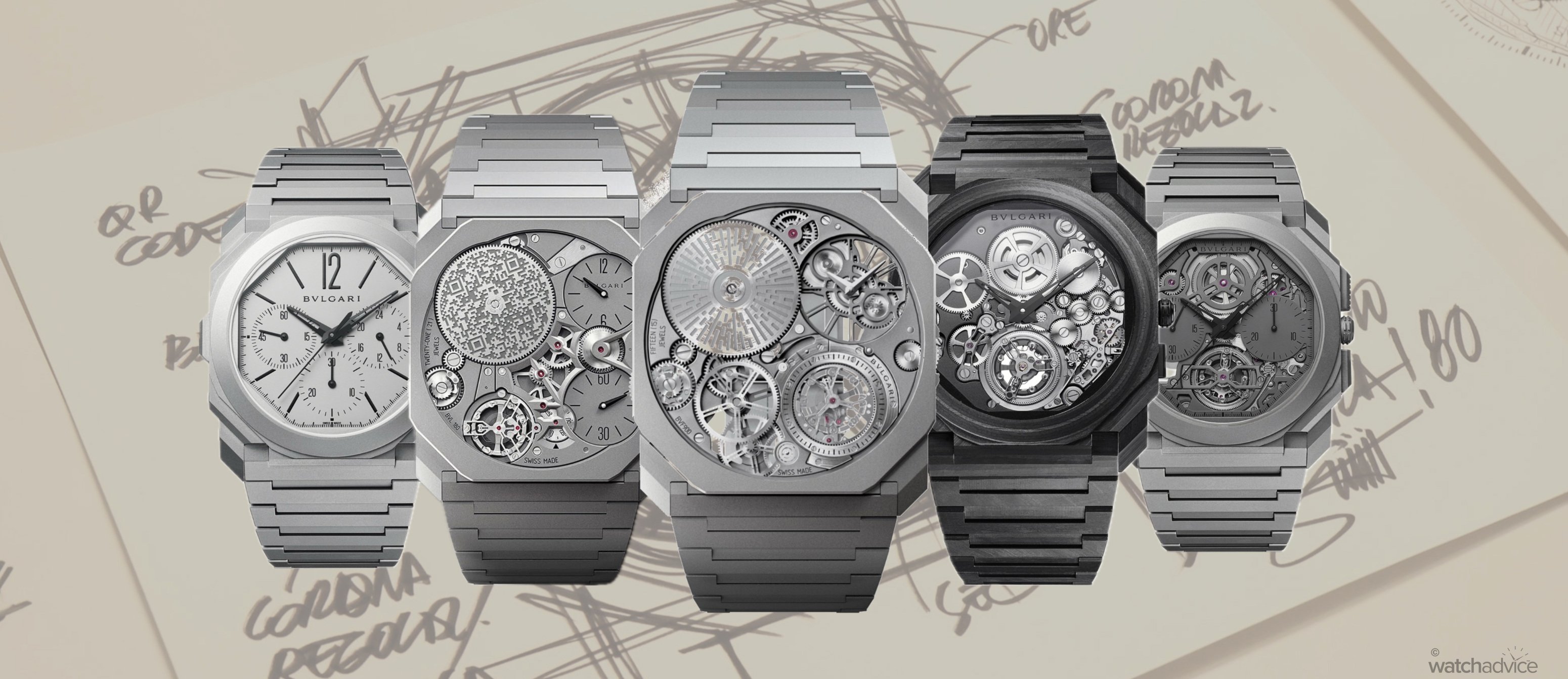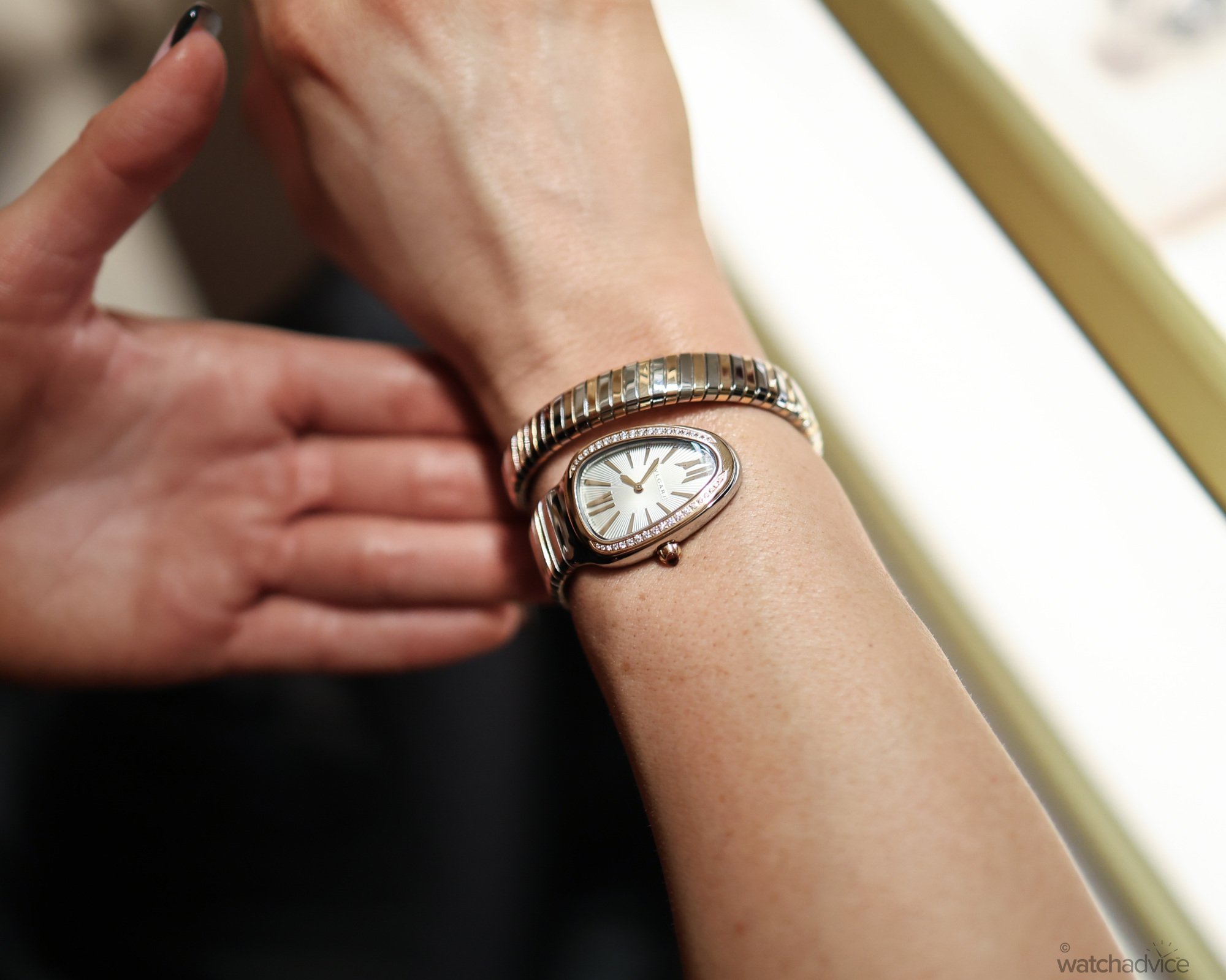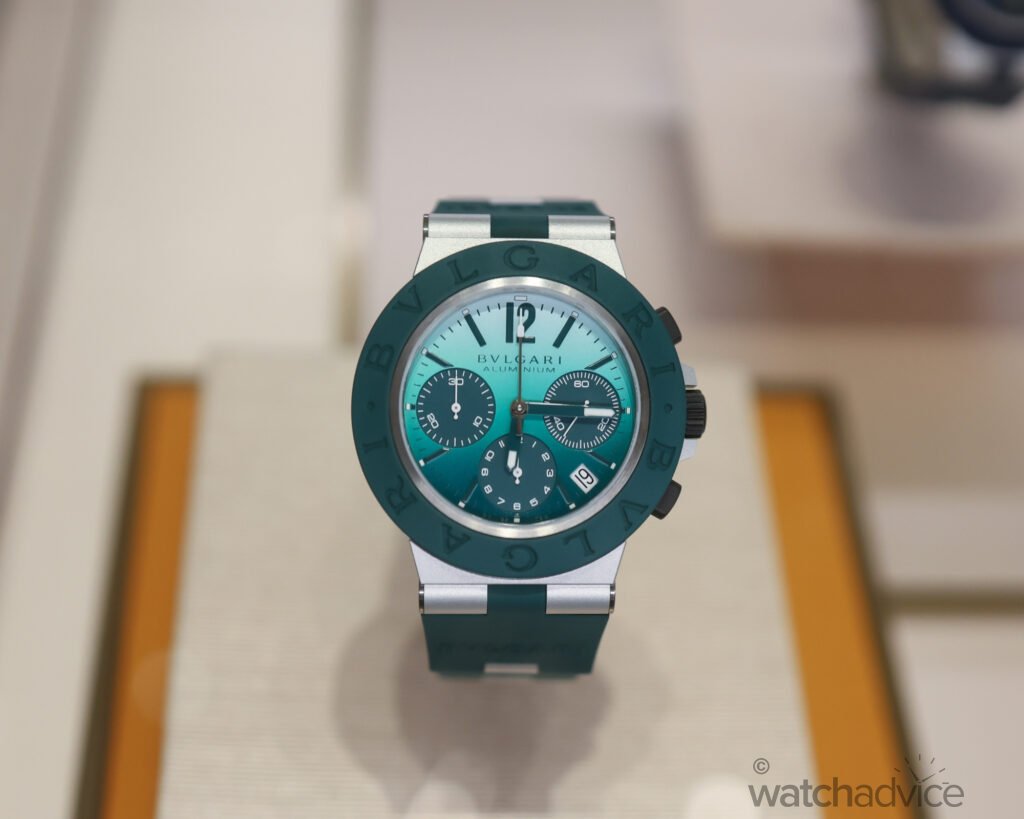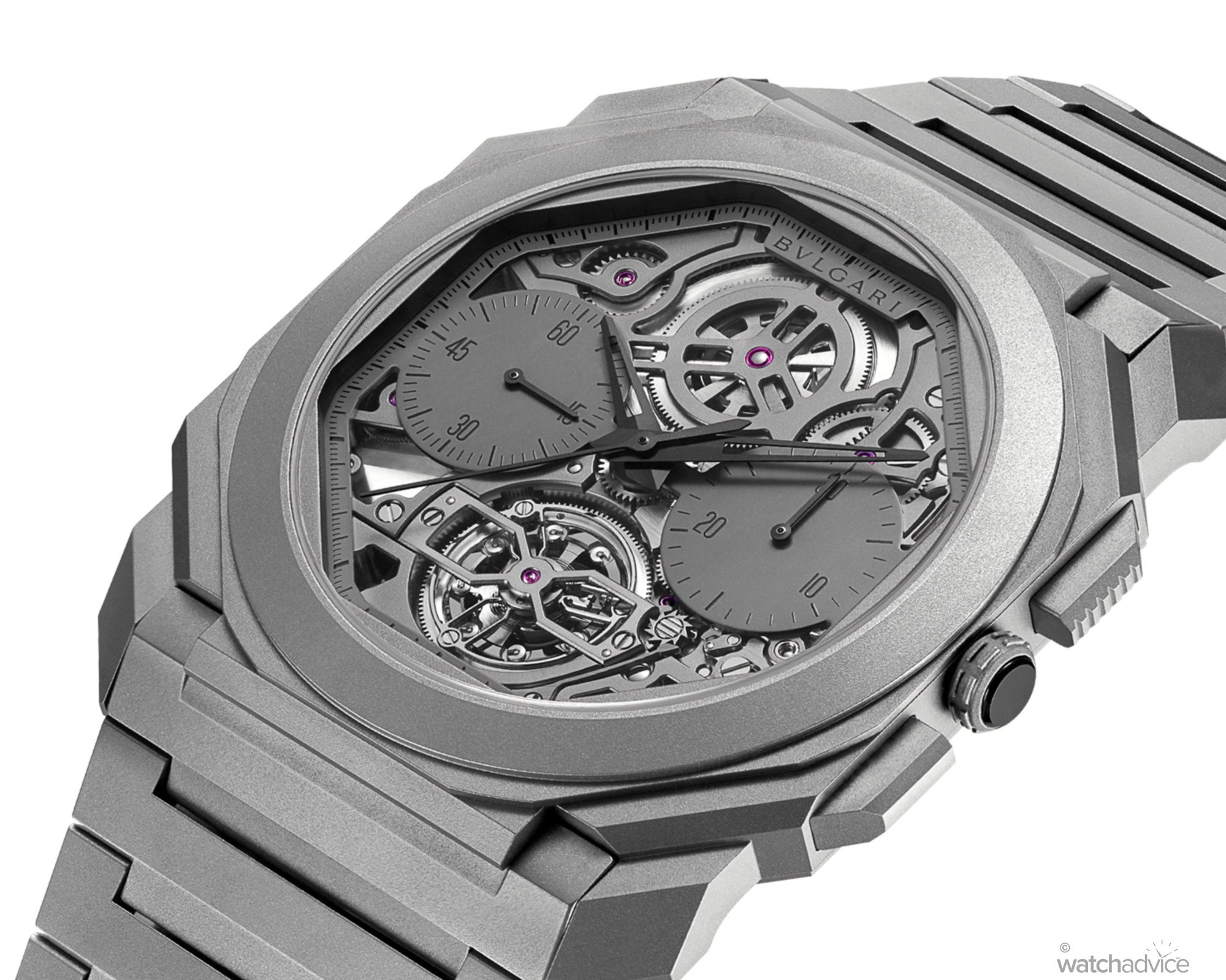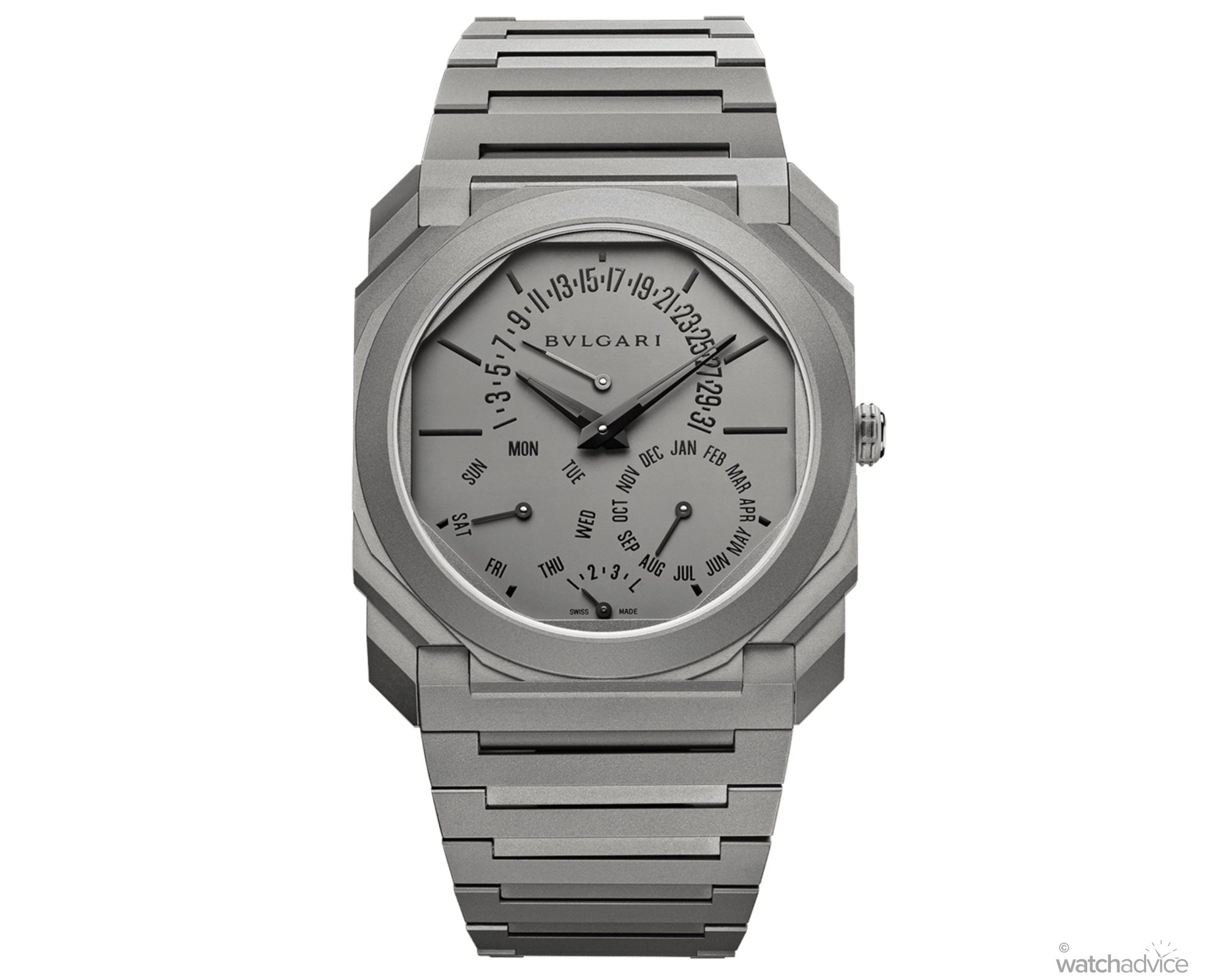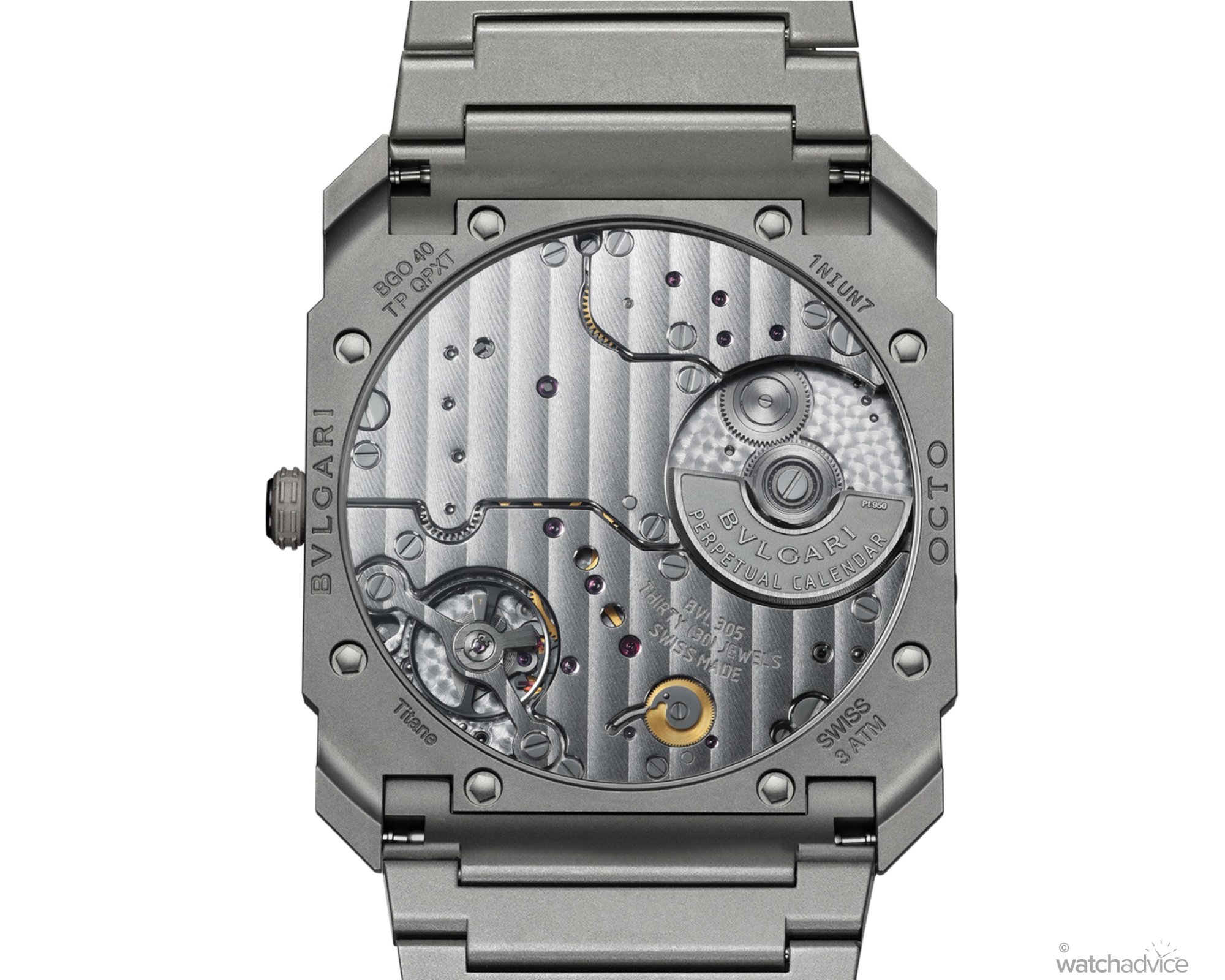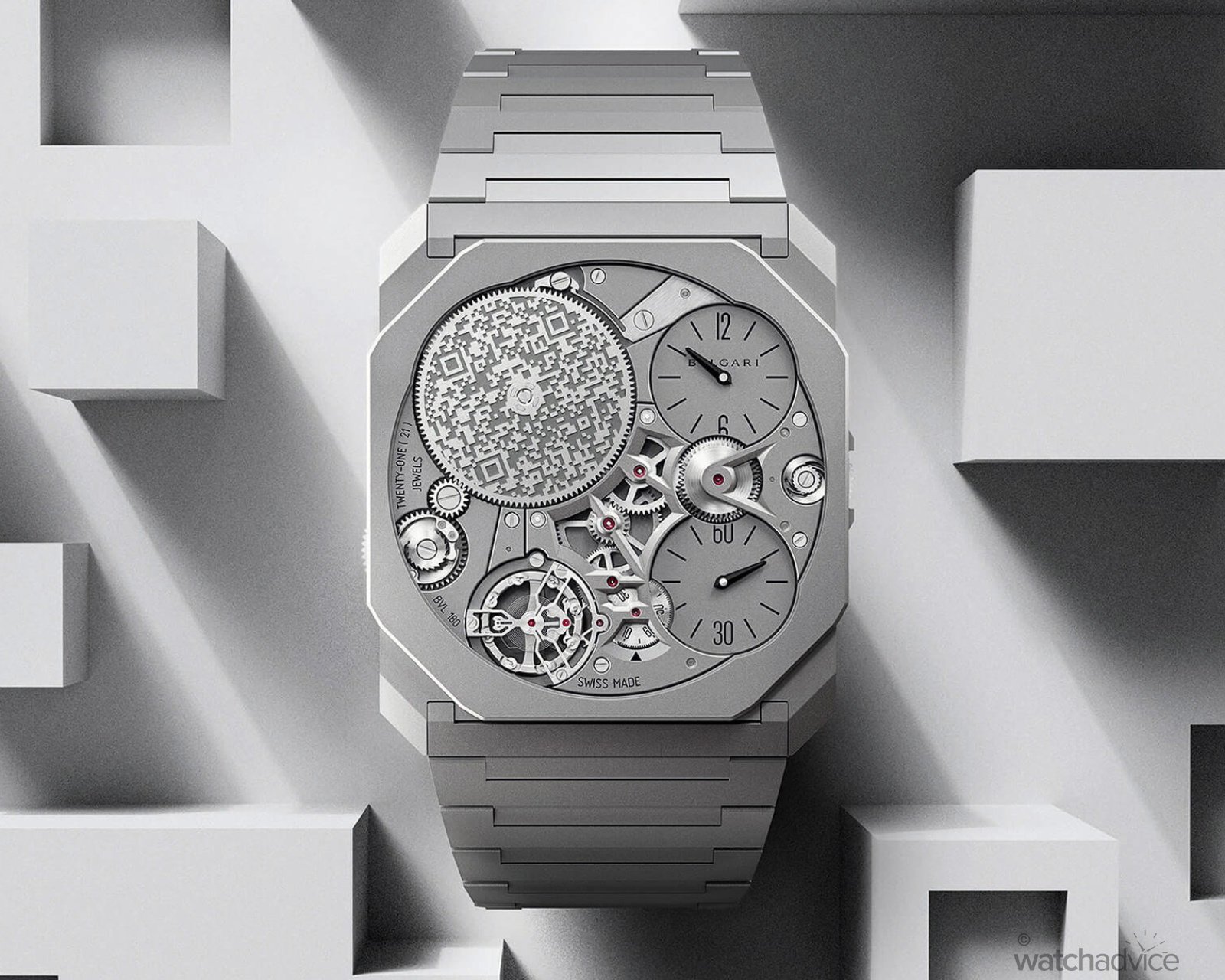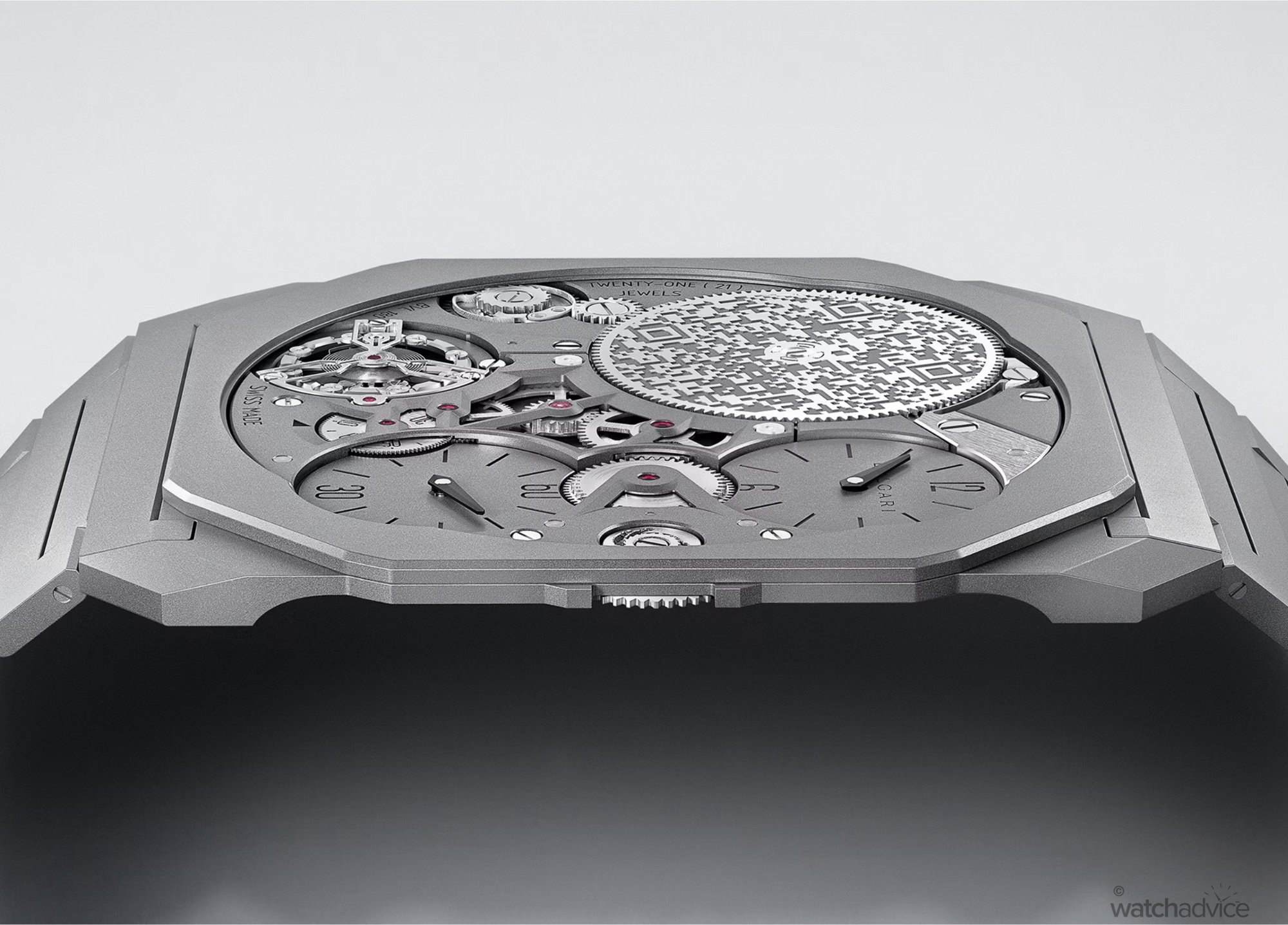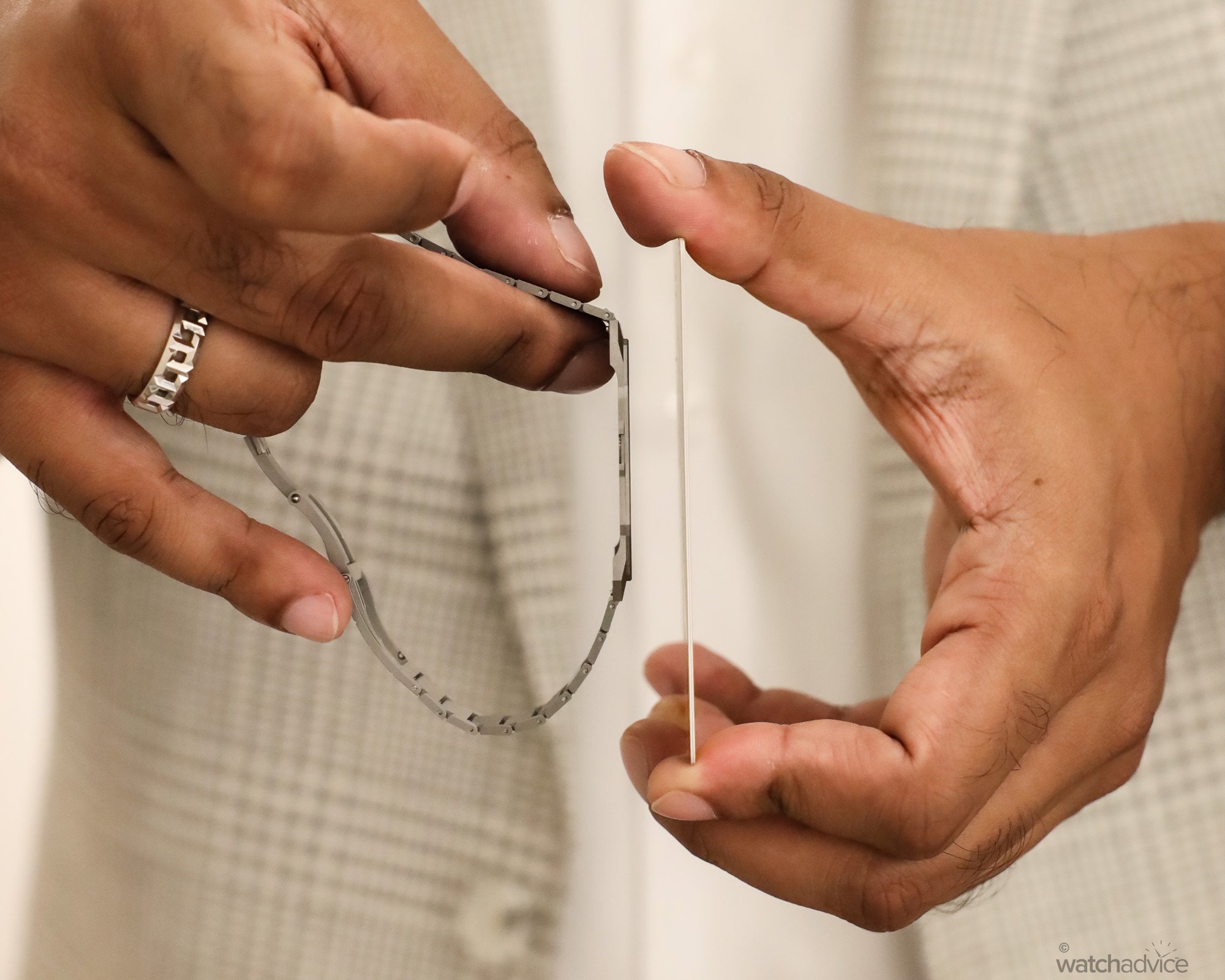Since 2014, Bvlgari has been breaking records when it comes to thin watches, especially when it comes to complicated pieces that are ultra-thin. We take a look back ot some of these record-breaking pieces.
Bvlgari are somewhat unique in the watch world for a few reasons. With bold designs that are very much entrenched in Roman design, thanks to Bvlgari’s beginnings, many of the collections in the Bvlgari stable are like no other. Think the Serpenti, Octo Finissimo and to an extent, the Octo collection overall. Bvlgari is also a brand that is rooted in Jewellery, which is imbued in many of its more creative pieces. On top of this, they are one of the very few Manufactures that are more or less vertically integrated with several facilities making all the components of the watches across Switzerland. Watch Advice visited the High Watchmaking facility, the Bvlgari Haute Horlogerie in Le Sentier, back in April to experience how the brand makes some of its most complicated pieces, as well as their ultra-thin movements.
Speaking of ultra-thin movements, this is one area where Bvlgari excels – both in non-complicated time-only pieces as well as complicated movements that house tourbillons, minute repeaters and chronographs. We saw quite a few examples of these while in Le Sentier, and they are works of art mixed with technical nous, and many out of the brilliant and creative mind of Fabrizio Buonamassa Stigliani – Bvlgari’s famed Head of Design. And it is these thin watches that we are going to explore today, as Bvlgari has been breaking records when it comes to thin watches since 2014.
A Quick Bit Of History
Bvlgari has been around since 1884, when it was founded by Greek silversmith Sotirio Bvlgari, who had immigrated to Rome. Bvlgari built its reputation on high-end jewellery, which was strongly influenced by Roman and Greek design cues: Colourful, big, and bold. Then in 1905, Bvlgari opened its first flagship store in Rome, on Via dei Condotti, a street still synonymous with high-end retail today. It is worth taking a stroll down it if you are ever in Italy.
Thanks to its designs, the brand built a reputation and was highly sought after by royalty and celebrities throughout the 1920s and 1930s. It wasn’t until the 1940s, however, that Bvlgari started making watches. These were understandably extensions of the jewellery, more specifically the Serpenti collection, designing the Serpeti Tubogas bracelet watch, which is still an icon today.
The introduction of watches in the Serpenti collection understandably meant that the focus for Bvlgari was on women’s watches. This continued into the 1950s and 1960s, and the movements in these were from reputable Swiss watchmakers, like Jaeger-LeCoultre and Vacheron Constantin. Who can forget the iconic pictures of Hollywood star Elizabeth Taylor, wearing a Bvlgari Serpenti?
In 1975, Bvlgari dived into the branded watch world with the inception of the Bvlgari Roma. Not commercially available, the watches were used as gifts for Bvlgari VIP clients and were simple digital quartz watches with a bezel engraved “BVLGARI ROMA,” inspired by ancient Roman coins. This design cue is still present today within the Bvlgari Bvlgari collection. Speaking of which, this led Bvlgari to bring out the Bvlgari Bvlgari collection in 1977, a watch that was designed in conjunction with now-famed designer Gerald Genta. Thanks to this, Bvlgari had officially entered the wider world of watchmaking.
Eventually, Bvlgari would move its watchmaking to Switzerland to further enhance the production and quality of the pieces it created and in the 1990s, expanded into men’s sports and dress watches. Fast forward to 2000, and Bvlgari acquired both Gerald Genta and Daniel Roth, which was a great move for the Roman brand, as this gave Bvlgari the ability to make their own movements and was the beginning of them being an integrated Manufacture. It also enabled Bvlgari to enter the world of High Horology with the expertise that came from both Genta and Roth brands, and later in the early 2000s, Bvlgari starts making watches with tourbillons, perpetual calendars and minute repeaters as part of their Haute Horlogerie division. And this brings us to the foray into the world of record-breaking watches that all kicks off in 2014…
Ultra Thin And Ultra Complicated
Since 2014, Bvlgari has managed to secure no less than ten world records when it comes to thin watches, and it is these ten records are what I wanted to focus on today. It seems that when it comes to thin watches, each year seems to create a new world record-breaking thin watch and with several brands always vying for the top spot, brands like Piaget, Vacheron Constantin, Richard Mille and of course, Bvlgari. In 2024, Konstantin Chaykin de-throned all the big players with the ThinKing, and manual-winding ultra-thin watch at 1.65mm, or about the same as a standard plastic credit card. But was it complicated? Not really. Complications in ultra-thin watches create another layer of complexity to what is already a complex exercise of making a movement that is normally 3mm, 4mm or 5mm thick, a little over 1mm. So, with this in mind, let’s dive into the watches that have broken records for Bvlgari, which I’ve summarised below for quick reference.
| Year | Model | Record Achieved | Calibre/Case Size |
|---|---|---|---|
| 2014 | Octo Finissimo Tourbillon | Thinnest tourbillon movement | 1.95mm/40mm x 5mm |
| 2016 | Octo Finissimo Minute Repeater | Thinnest minute repeater | 3.12mm/40mm x 6.85mm |
| 2017 | Octo Finissimo Automatic | Thinnest automatic watch | 2.23mm/40mm x 5.15mm |
| 2018 | Octo Finissimo Tourbillon Automatic | Thinnest automatic tourbillon | 1.95mm/42mm x 3.95mm |
| 2019 | Octo Finissimo Chronograph GMT Automatic | Thinnest chronograph + GMT | 3.3mm/42mm x 6.9mm |
| 2020 | Octo Finissimo Tourbillon Chronograph Skeleton Automatic | Thinnest tourbillon chronograph | 3.5mm/42mm x 7.4mm |
| 2021 | Octo Finissimo Perpetual Calendar | Thinnest perpetual calendar | 2.75mm/40mm x 5.8mm |
| 2022 | Octo Finissimo Ultra (manual time-only) | Thinnest mechanical watch | 1.5mm/40mm x 1.8mm |
| 2024 | Octo Finissimo Ultra COSC (manual) | Thinnest certified mechanical watch | 1.5mm/40mm x 1.7mm |
| 2025 | Octo Finissimo Ultra Tourbillon | Thinnest tourbillon watch | ~1.8mm/40 x 1.85mm |
2014 – Bvlgari Octo Finissimo Tourbillon
This is the watch that started the record-breaking run for Bvlgari. Launched in 2014 and selected as a finalist at that year’s GPHG, the Bvlgari Octo Finissimo entered the record books as having the thinnest tourbillon movement in the world – a mere 1.95mm thin. It was housed in the Octo Finissimo 40mm case, which itself was just 5mm thin and made from platinum. This, at the time, was groundbreaking as Bvlgari created the tourbillon cage first, and then built the rest of the movement around it.
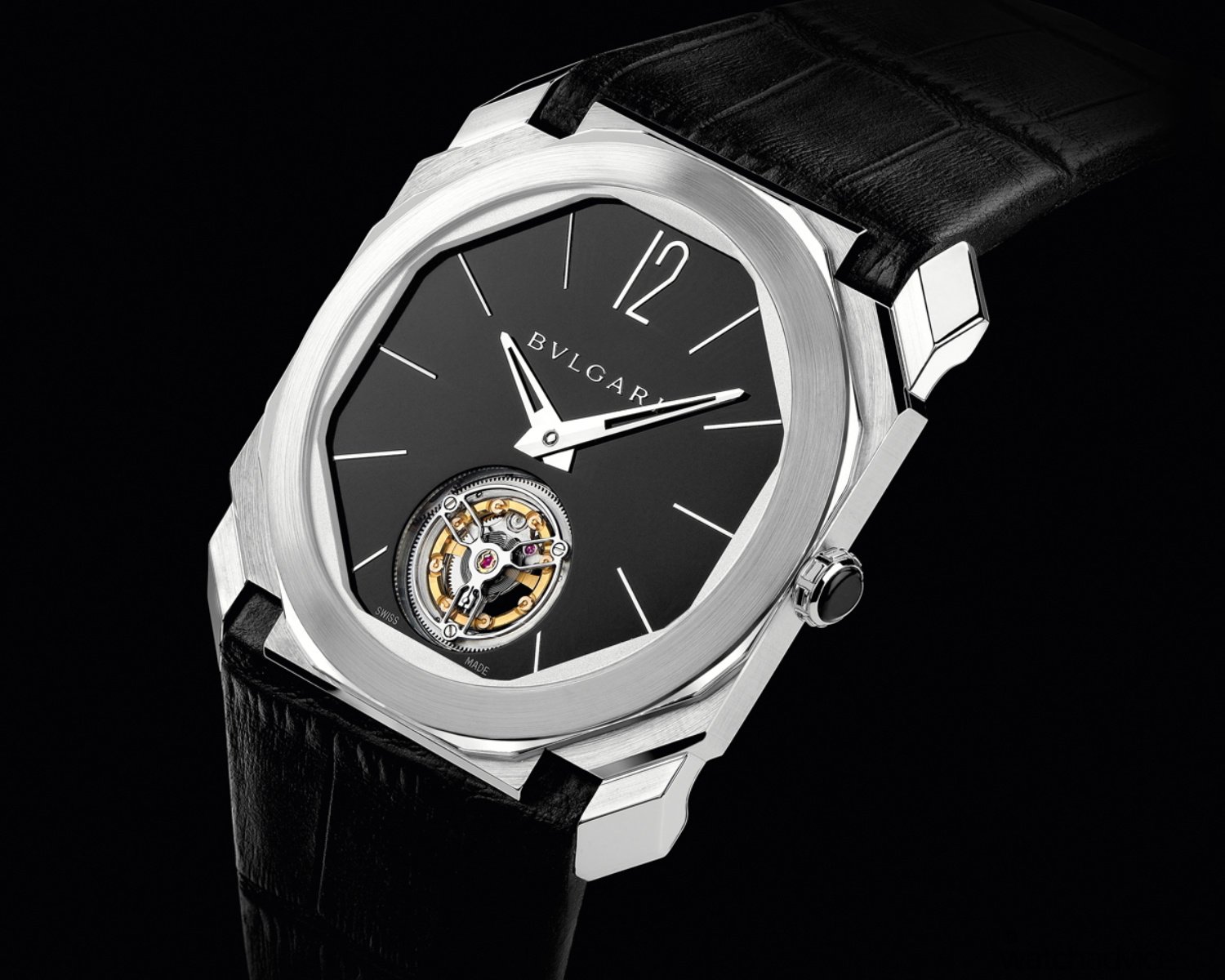
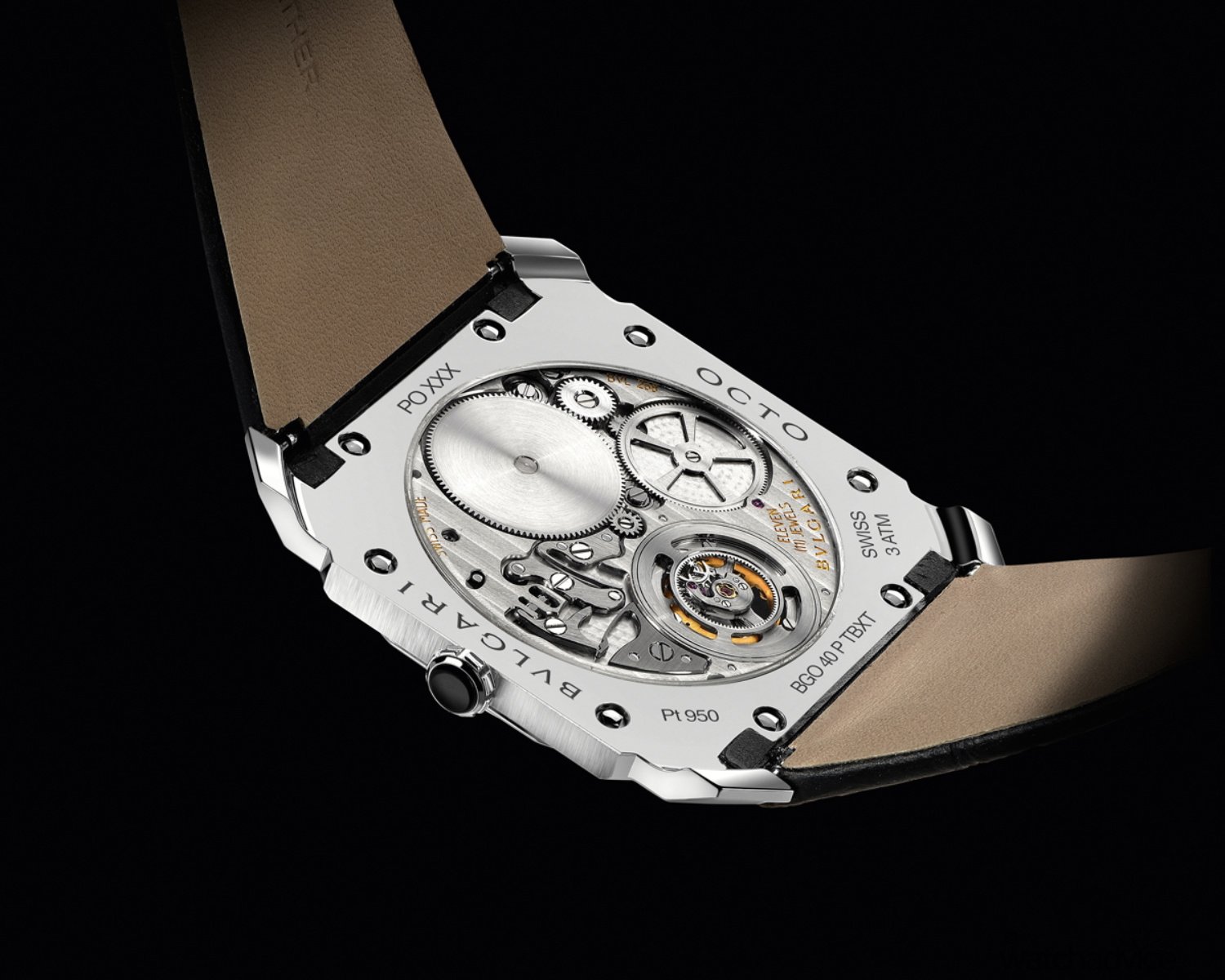
The Calibre BVL268 housed 249 components, was a manual winding movement with a 52-hour power reserve and beating at 3Hz / 21,600 VpH. And even though this was an exercise in thinness, Bvlgari still finished the movement off with decorative finishes such as Côtes de Genève, the gears were bevelled and circular satin-brushed, screw heads and slots bevelled, and the ends were polished. When launched, it had a retail price of CHF 130,000 + VAT.
2016 – Bvlgari Octo Finissimo Minute Repeater
Just a short two years later, Bvlgari was at it again with the release of the Octo Finissimo Minute Repeater that became the world’s thinnest minute repeater watch. Taking on the same bold forms as the tourbillon, the new watch now housed the BVL362 Chiming Calibre. The calibre itself measures 3.12mm thick, and due to the minute repeater and Bvlgari working hard to get a crystal clear sound, the 40mm titanium case measures 6.85mm thick. This took the record away from Piaget, who, up until the Octo Finissimo Minute Repeater, held the record with a movement that was 4.8mm in a case that measured 9.4mm in thickness.
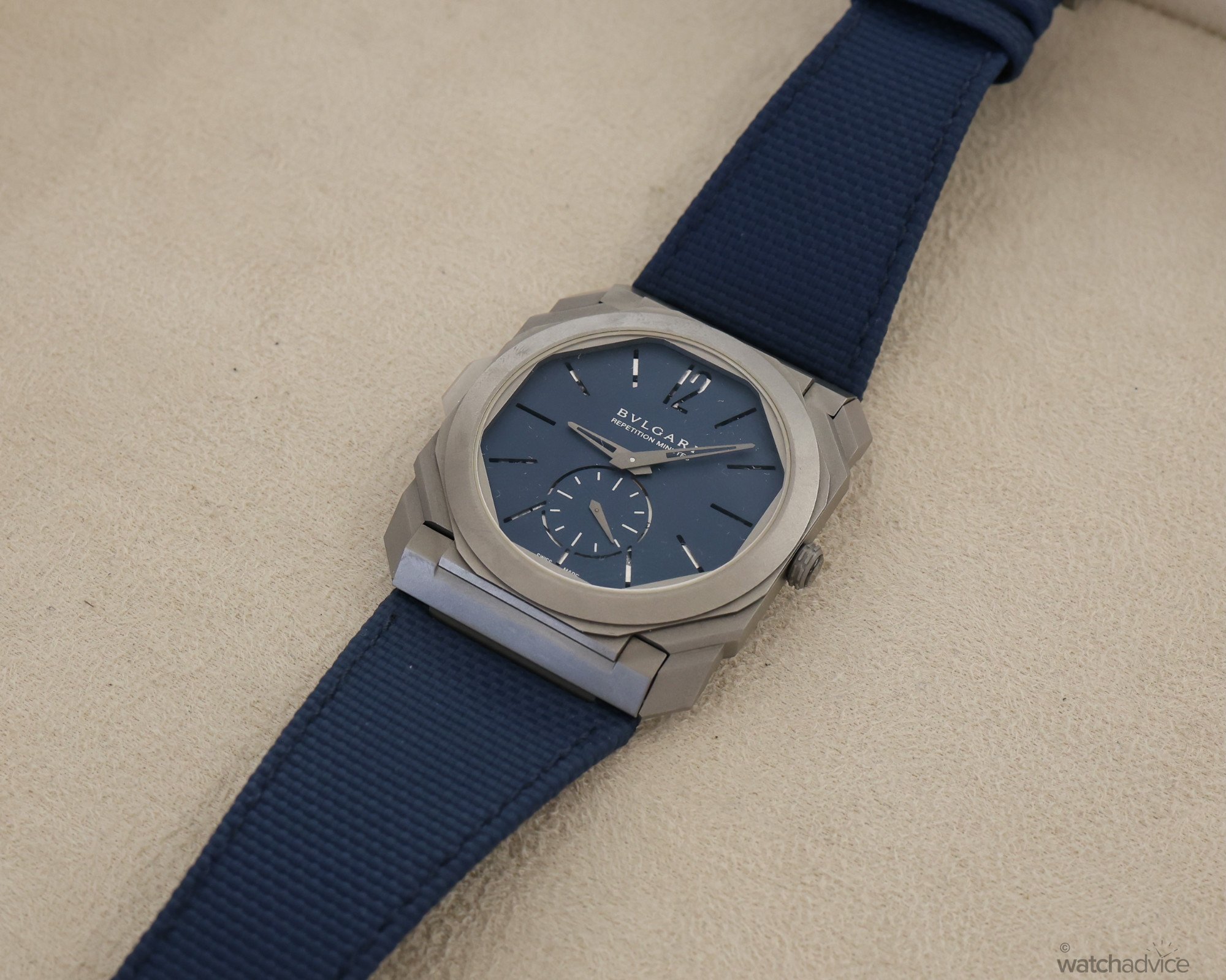
To make sure the minute repeater has a clear sound, the watch was crafted from Titatium thanks to its resonance properties, and if you notice, the dial’s indices and small seconds are cut out, sandwich style, to allow more of the sound to escape from the watch. I’ve heard this in person, and it does sound beautiful and amazing that this can come from such a thin watch. The Calibre BVL362 has a 42-hour power reserve and is hand-wound, and yes, limited in production to just 50 pieces. When launched, this piece had a price tag of CHF 160,000, and today, it still holds the record for the world’s thinnest minute repeater.
2017 – Bvlgari Octo Finissimo Automatic
By 2017, Bvlgari had realised it was onto a good thing, and it seems to be pretty good at breaking world records when it comes to thin watches. So, they’ve conquered a few complications, so why not an automatic watch? In 2017, they did this with the still-in-production Octo Finissimo Automatic, becoming for a short while, the world’s thinnest automatic watch. This is a piece that I am now very familiar with, having just done a hands-on review on the watch recently.
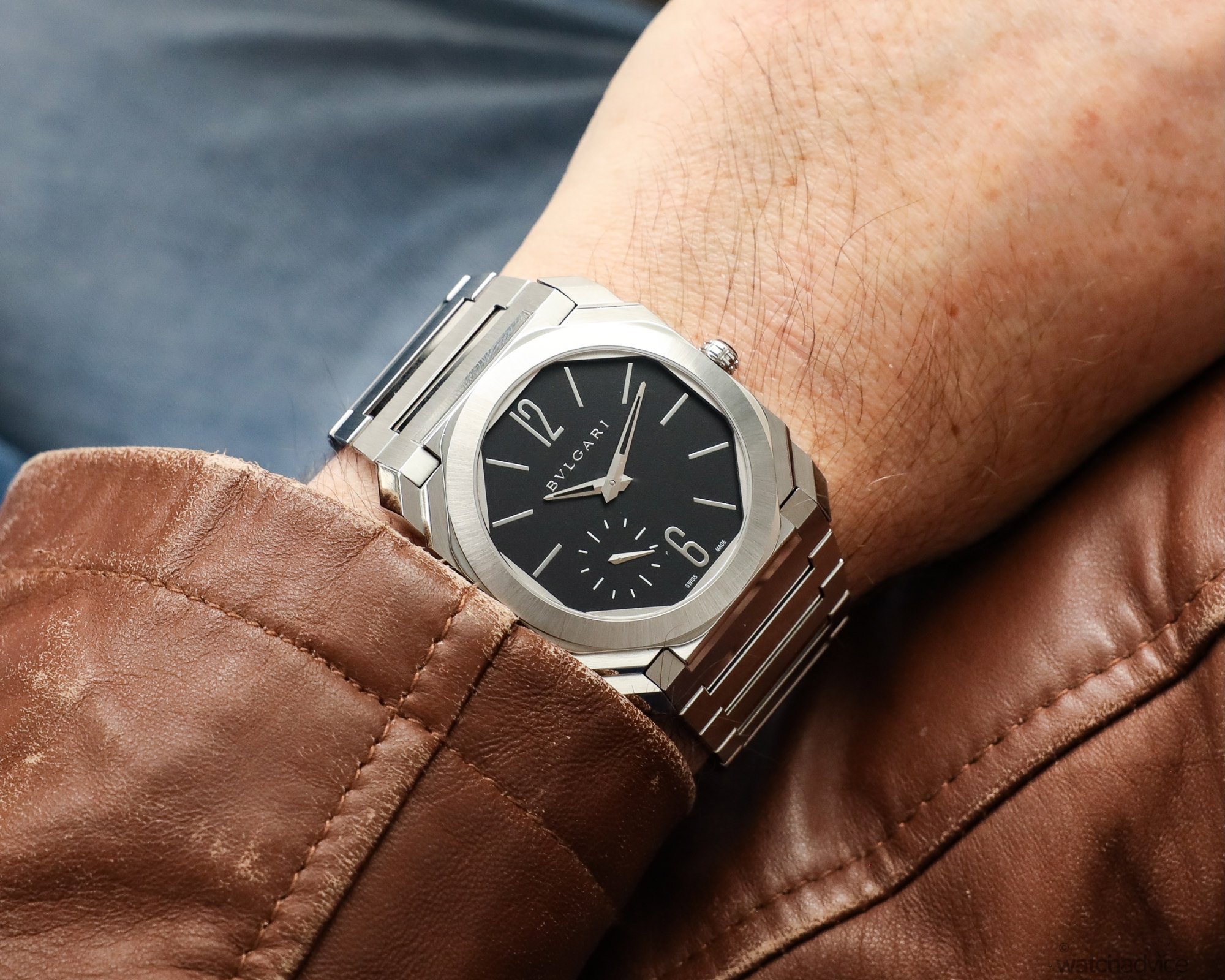
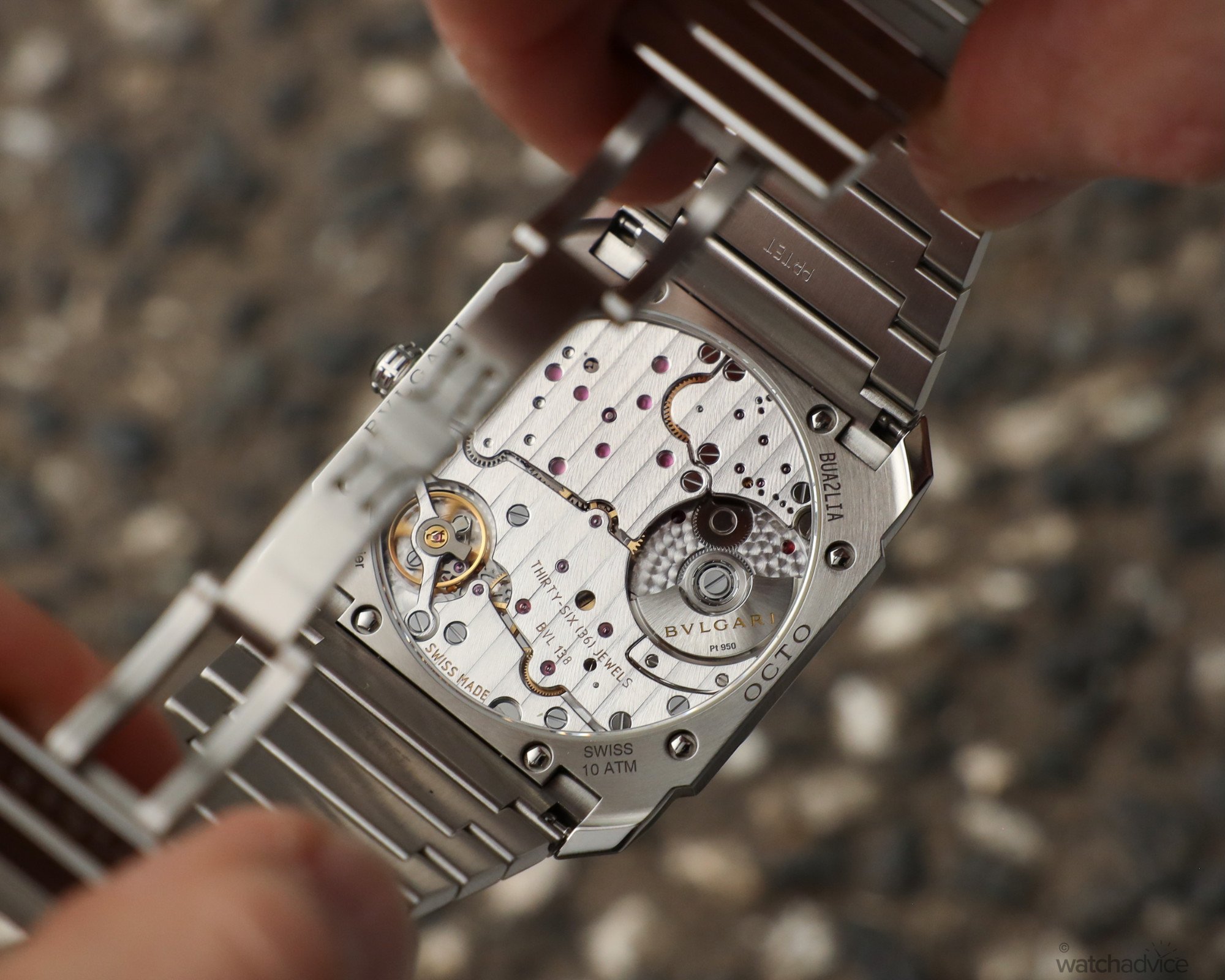
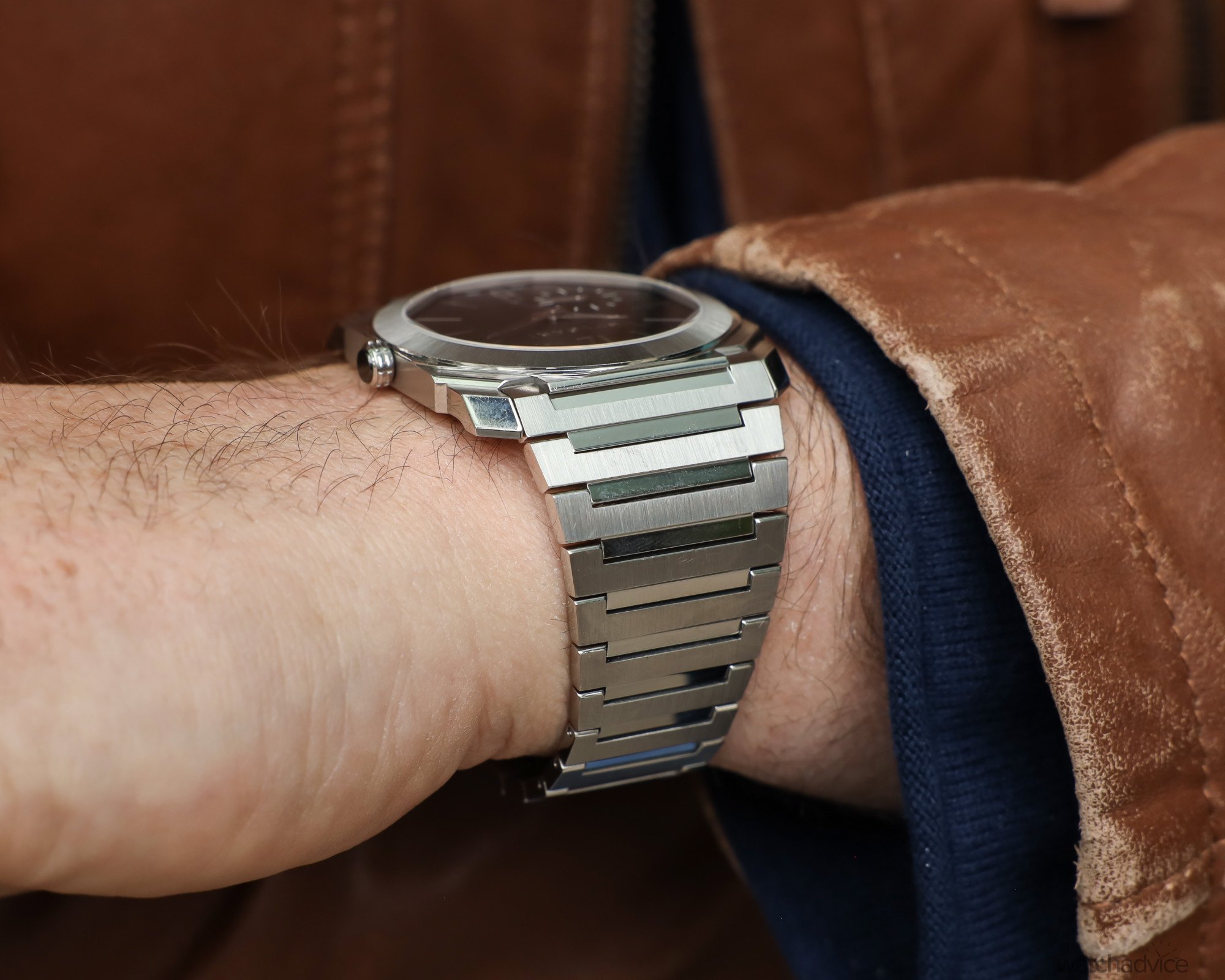
Bvlgari was able to create the Calibre BVL138 automatic movement via their Manufacture in Le Sentier, and achieved this by the use of the micro-rotor as well as re-designing the movement’s architecture to be wide and flat. This allowed for an automatic movement that was a slender 2.23mm thin, and still is today. This was, at the time, cased in a 5.15mm thick case (now 6.5mm for commercial purposes) and held the record briefly until Piaget brought out the Altiplano Ultimate Concept later that year at 4.3mm. However, today’s version of the watch is highly wearable, not flimsy at all and has 100m water resistance with a screw down crown, so it is a robust everyday watch. The current Australian RRP is A$22,400
2018 – Bvlgari Octo Finissimo Automatic Tourbillon
If you have been able to create the world’s thinnest tourbillon and the world’s thinnest automatic watch, why not combine them to create the world’s thinnest automatic tourbillon? And this is exactly what Bvlgari did with the Octo Finissimo Automatic Tourbillon. In the slightly wider 42mm Octo Finissimo case, this case measures just 3.95mm thick, thanks to the 1.95mm thick movement inside the BVL288.
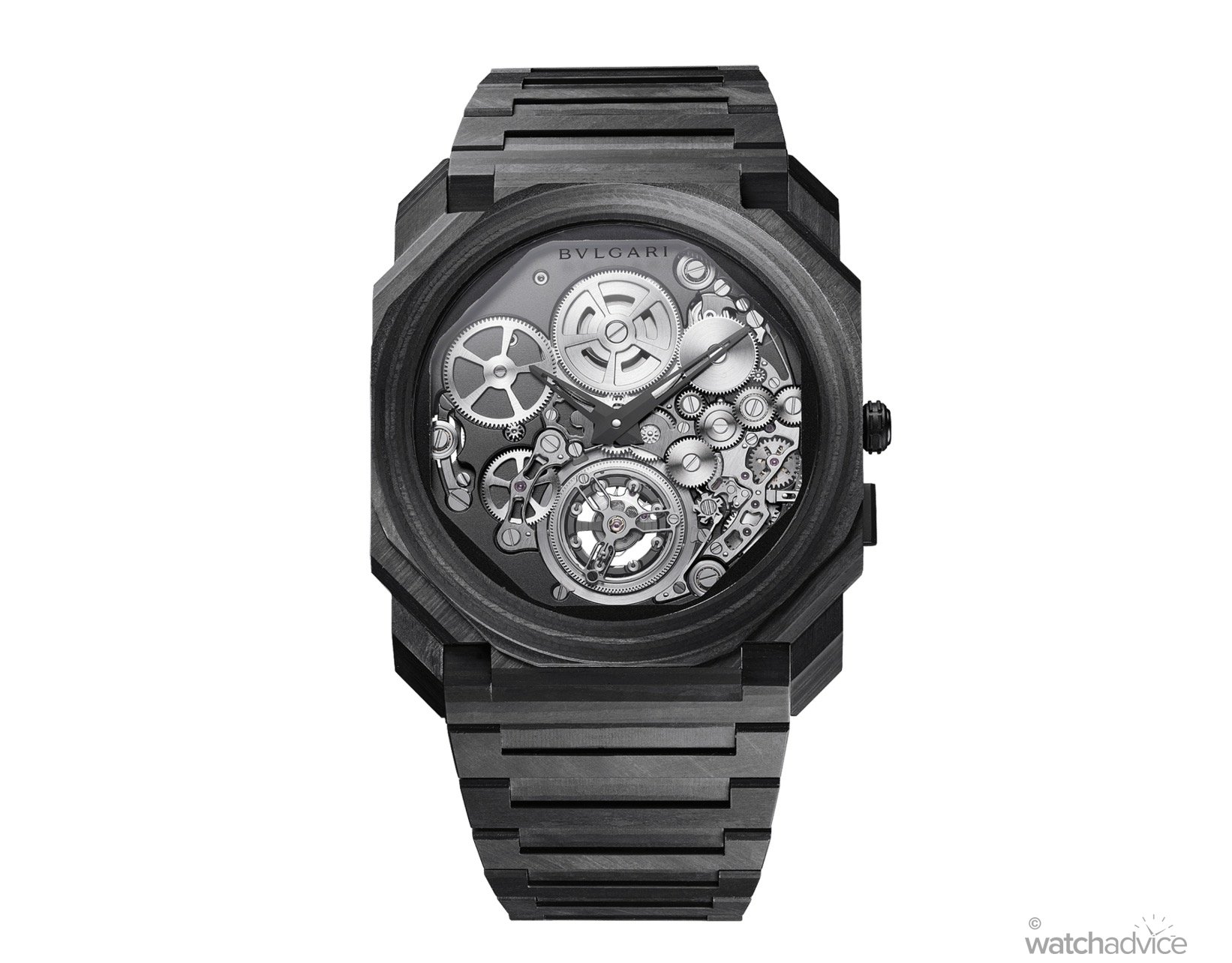
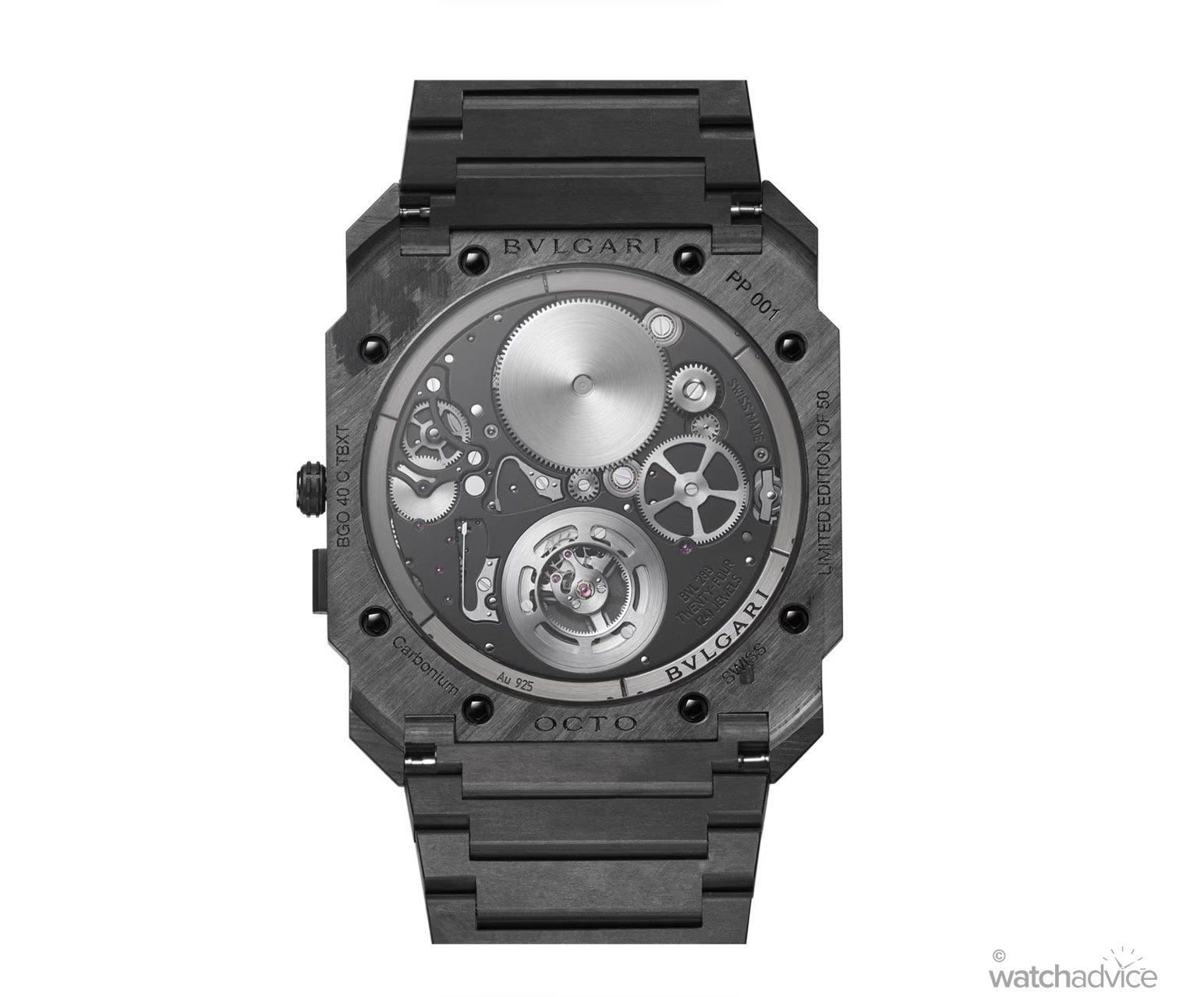
What set the BVL288 apart and helped to maintain the thin size was the peripheral rotor. This allowed Bvlgari to modify the architecture of the previous 1.95 mm-thick tourbillon movement from 2014, but adjusted the gear train to accommodate the peripheral rotor that powers the watch. This is the major reason the movement is slightly wider as is the watch. The BVL288 has a 52-hour power reserve with the one-minute tourbillon at 6 o’clock. When launched, it retailed at CHF 120,00 for those lucky enough to acquire one.
2019 – Bvlgari Octo Finissimo Chronograph GMT Automatic
Chronographs are not normally a complication that you associate with a thin movement. Add a GMT function to this as well, and most brands would struggle to keep the case size under 10mm. However, in 2019, Bvlgari did this, creating a GMT and a Chronograph with an automatic movement in the Octo Finissimo case that was 42mm x 6.9mm thick, slightly thicker than the standard automatic and the tourbillon.
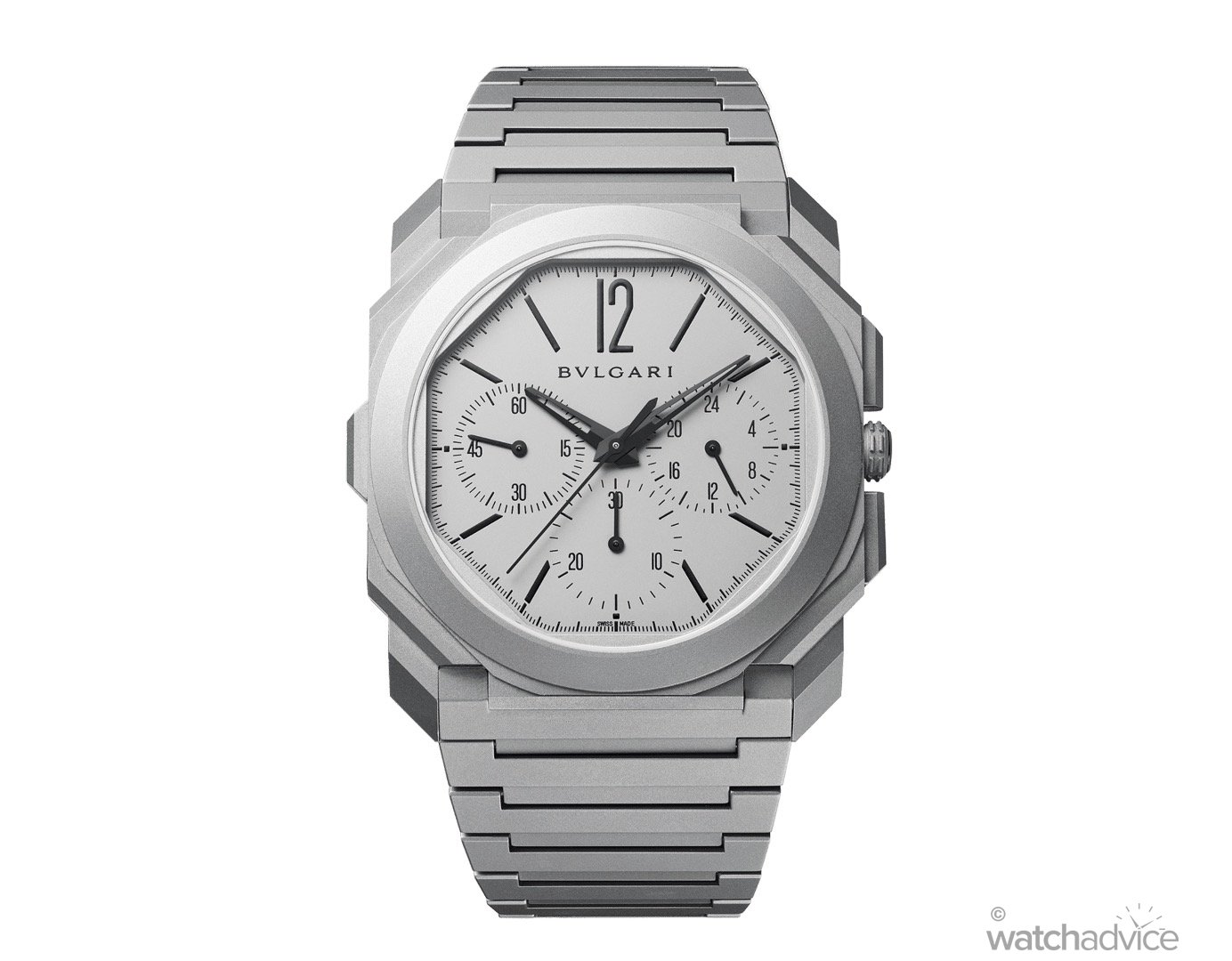
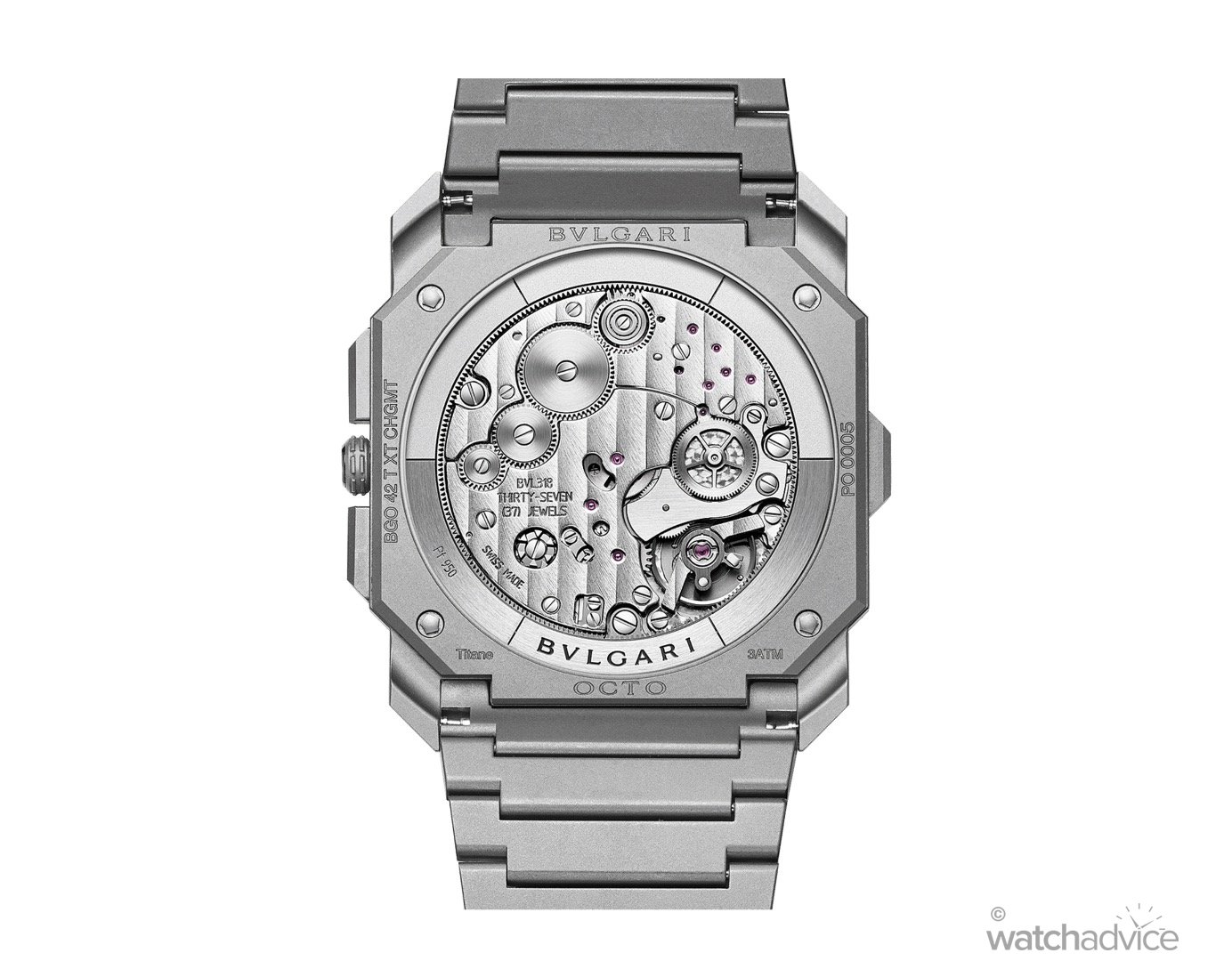
Inside this piece is Bvlgari’s BVL318 calibre, which houses the chronograph and GMT functions in a movement that is 3.3mm thin. Bvlgari utilises the perhperal rotor again to help keep the slimness of the movement down and encompasses a very respectable 55-hour power reserve. This is another record breaker that is still in the Bvlgari collection today, with both a steel and a titanium option. The steel is slightly larger at 43mm but does have 100m water resistance where whereas the titanium is 42mm with a 30m water resistance. Retail pricing is A$28,400 for steel and A$32,000 for the titanium.
2020 – Bvlgari Octo Finissimo Tourbillon Chronograph Skeleton Automatic
Yes, it’s a long title for a watch, but it perfectly describes this next record-breaking thin watch from Bvlgari. Over the prior six years, Bvlgari set the records for the tourbillon, the automatic tourbillon and a chronograph, so the next step was to again combine these into a single watch to create the world’s thinnest tourbillon chronograph. To show it all off, Bvlgari put this all into a skeletonised piece to show off the calibre, which, let’s face it, why not?!
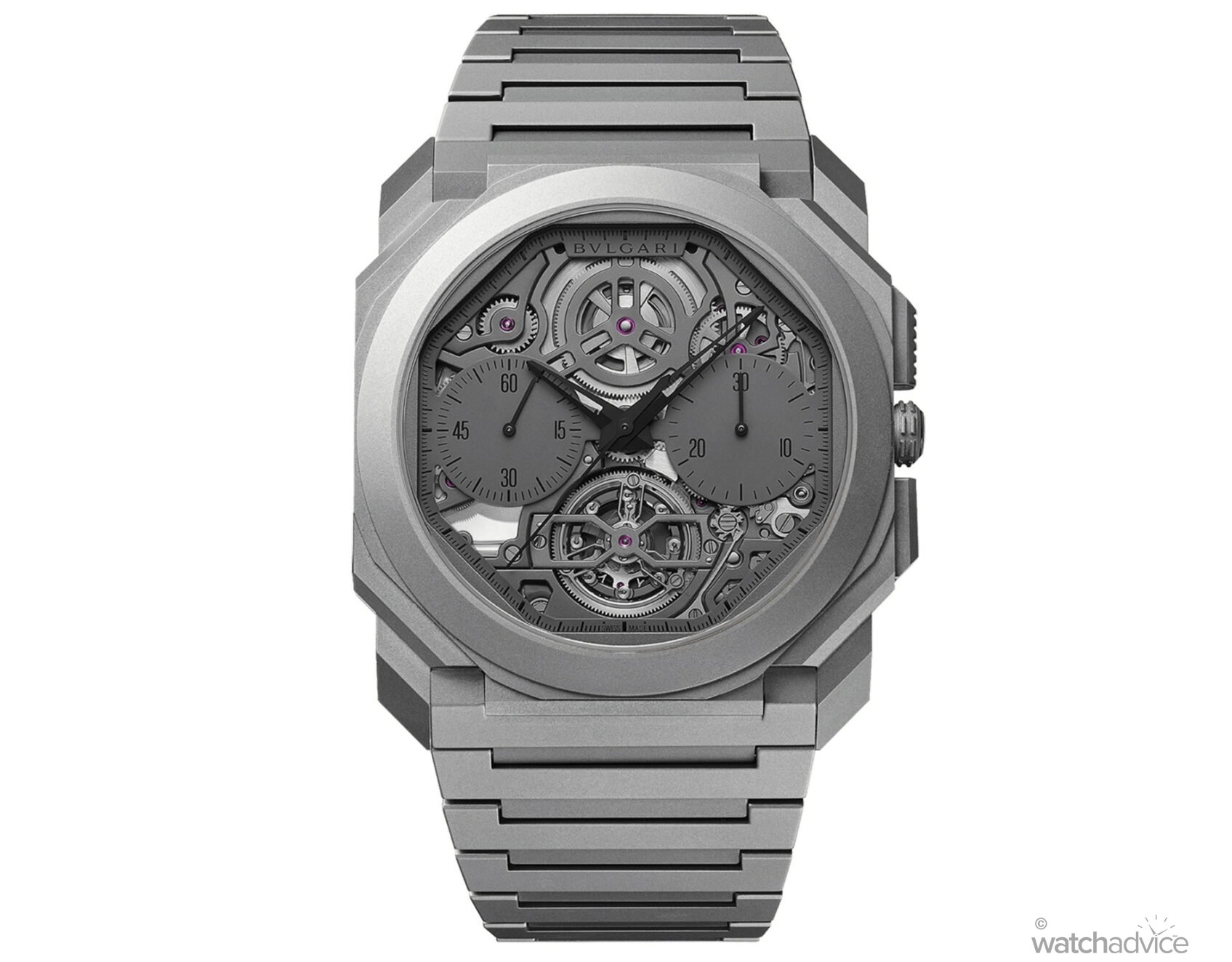
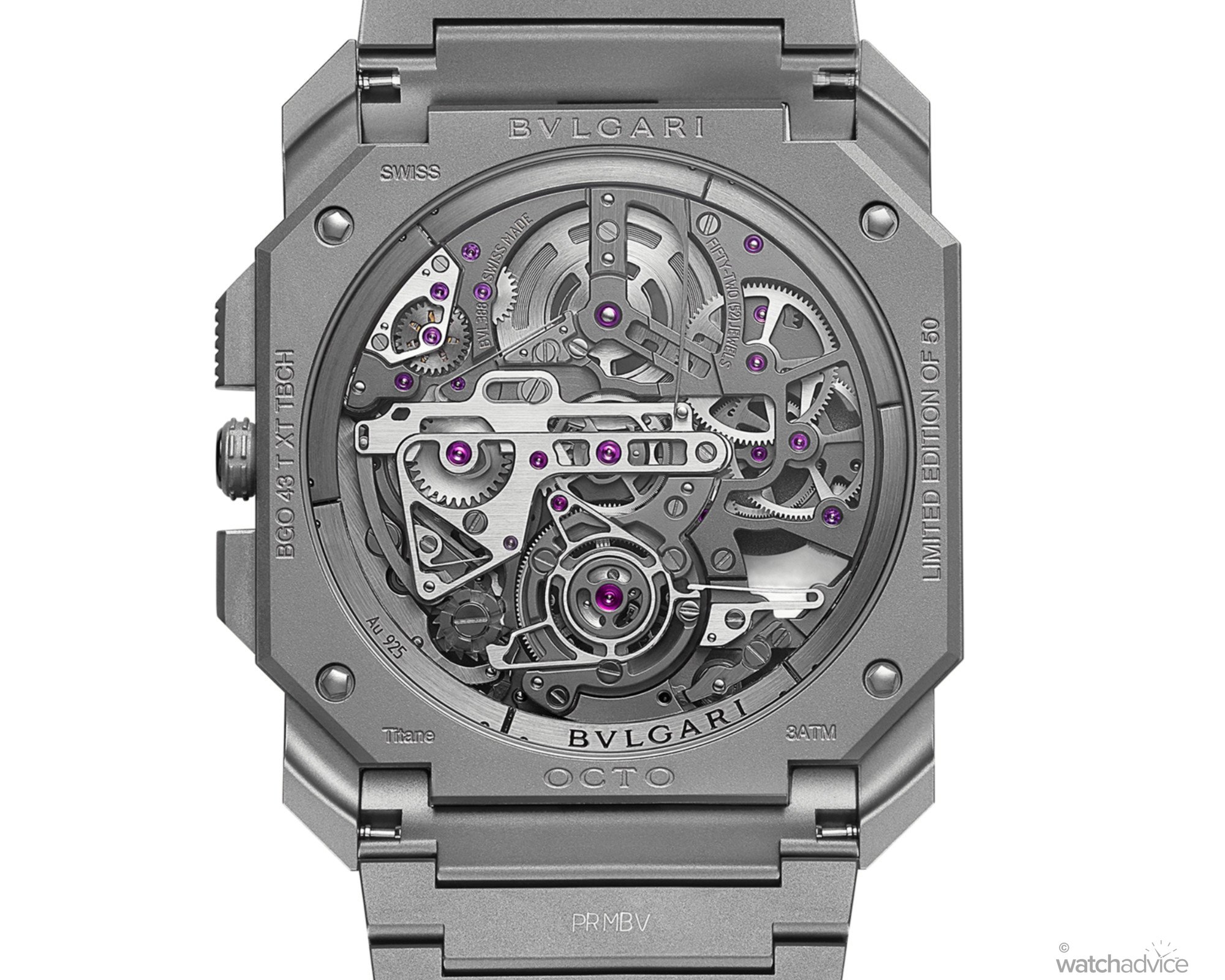
When this was launched in 2020, it was done so in the 42mm sandblasted titanium case, which itself measured only 7.4mm thick. Inside is the 3.5mm thin Calibre BVL388, which was a new calibre for Bvlgari, but based on previous calibres gone before it, like the BVL318 found in the Chronograph GMT above. For this model, Bvlgari has opted not to use the ultra flat flying tourbillon like in previous models (it’s fixed), which is a testament to how Bvlgari has designed the movement and incorporated a mono-pusher chronograph. Yes, there are two pushers on the watch, but the pusher at 2 o’clock is the start, stop and reset, whereas the pusher at 4 o’clock is used to control the crown functions. At position one, the crown winds the watch, push the button at 4, and you can now set the time.
There is a massive amount of technical mastery in this watch, too much for this article if I’m being honest, but to summarise in a nutshell, how Bvlgari has designed the movement to save space and ensure the functionality of the watch is nothing short of marvellous. Even with the amount of space, or lack thereof, Bvlgari has still been able to squeeze 52 hours of power out of the watch, assisted by the white gold oscillating peripheral rotor that circumnavigates the movement. This is still a piece that could be purchased on demand according to Bvlgari’s site, but when launched, it was limited to just 50 pieces and cost approximately €150,000.
2021 – Bvlgari Octo Finissimo Perpetual Calendar
Next up on the list was a piece Bvlgari hadn’t tried before in the world’s thinnest rankings, or at least, broken the record for, and that was to create the world’s thinnest perpetual calendar, or QP (Quantième Perpétuel) watch. Again, the Octo Finissimo provided the canvas for this watch.
Perpetual Calendars are genius in their engineering regardless of the case or calibre size. The ability to be able to track the day, date, month, year and leap years, plus the moon phase in some cases, accurately over hundreds of years and only needing to be adjusted every hundred years or so with gears, wheels and cogs is amazing. For Bvlgari to do this in an ultra-thin Calibre, the BVL305 is another. The calibre itself is only 2.75mm thick, housed in a 40mm case that is just 5.8mm thick.
Bvlgari has smartly designed the watch, both utilising the space on the dial through different layouts for the functions, as well as the way the calibre has been designed, with all 408 components fitting nicely into the ultra-thin movement, giving the watch its 60-hour power reserve from the micro-rotor. On the dial, it showcases the date and the leap year in a retrograde fashion and the day of the week and month on two subdials at 5 and 7 o’clock. This gives the dial somewhat of a balance while maintaining the legibility of all the calendar indications.
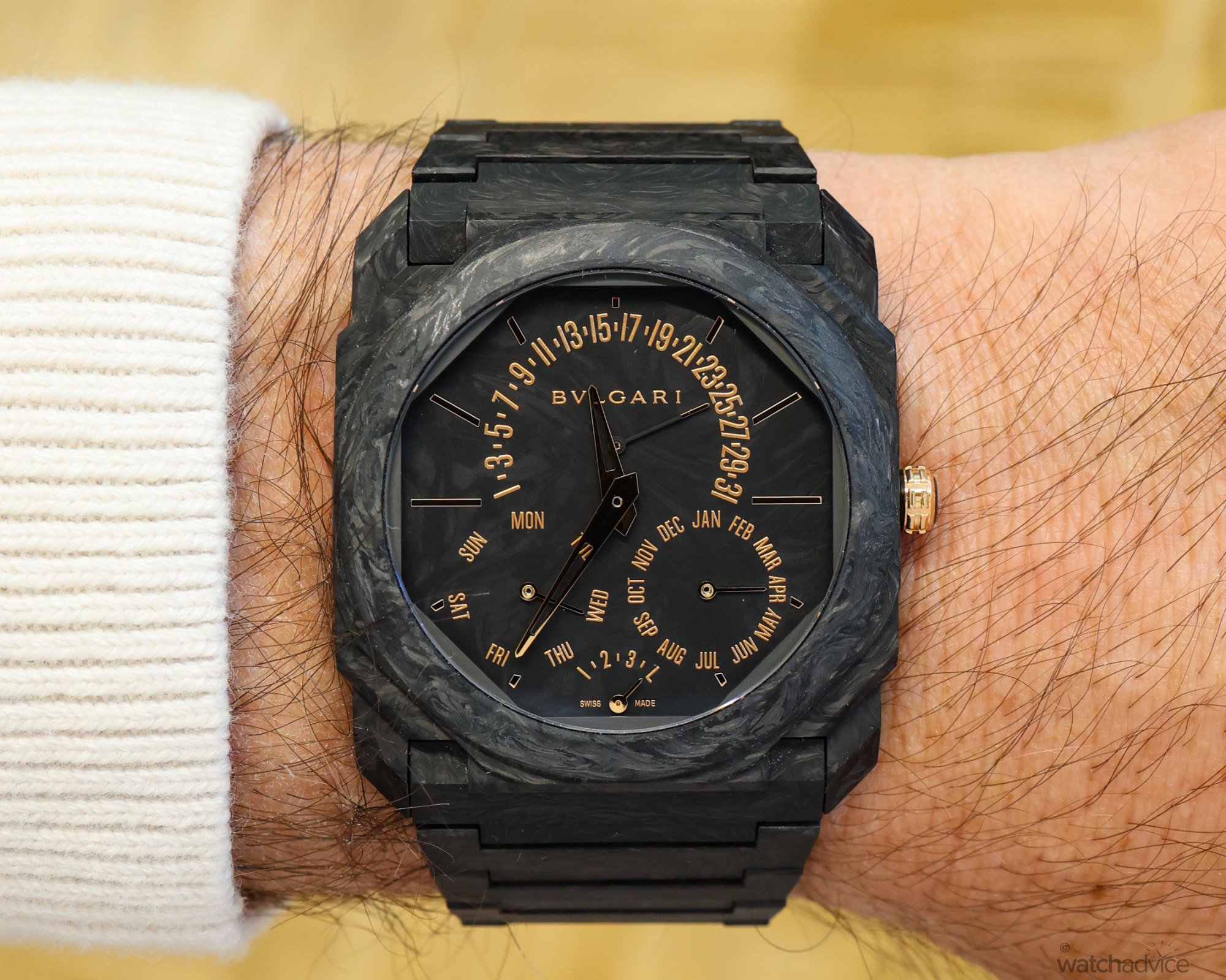
Launched in both titanium (shown above) and platinum, this piece was another notch on Bvlgari’s thinnest record-breaking watch run. The titanium retailed for €60,000, and the platinum, €90,000. To buy, this is a POA via Bvlagri today.
2022 & 2024 – Bvlgari Octo Finissimo Ultra & Ultra COSC
Going back to basics, well, sort of, Bvlgari in 2022 released the Octo Finissimo Ultra and set the record for the world’s thinnest mechanical watch at a very wafer-thin 1.8mm. Yes, 1.8mm and that is cased, with a 1.5mm movement inside. This is micro-engineering at its finest and showcases Bvlgari’s drive to push the limits of what is possible in mechanical watchmaking. Then, not to be outdone by others, like Piaget and Richard Mille, in 2024, Bvlgari went one step further with this and was able to cut down the watch by 0.1mm to be 1.7mm.
The movement Bvlgari has inside is the BVL180 calibre, which is 1.5mm thin and uses an ingenious method for telling the time via the use of two dials, one for the hour and one for the minute hand. It has also put the movement on display, meaning no wasted depth for a dial, plus it is a way for us to admire the workmanship put into the BVL180. On top of the barrel, the is a QR code that the owner could scan, leading to an NFT linked to the watch and video on it.
In 2024, having lost the thinnest mechanical watch crown, Bvlgari releases the new version of the Octo Finissimo Ultra, this time with a COSC-certified movement. This became the thinnest mechanically certified watch in the world, another title Bvlgari was happy to take. Here, Bvlgari used the same 1.5mm thick BVL180 calibre, but was able to shave down the case to 1.7mm to take the title.
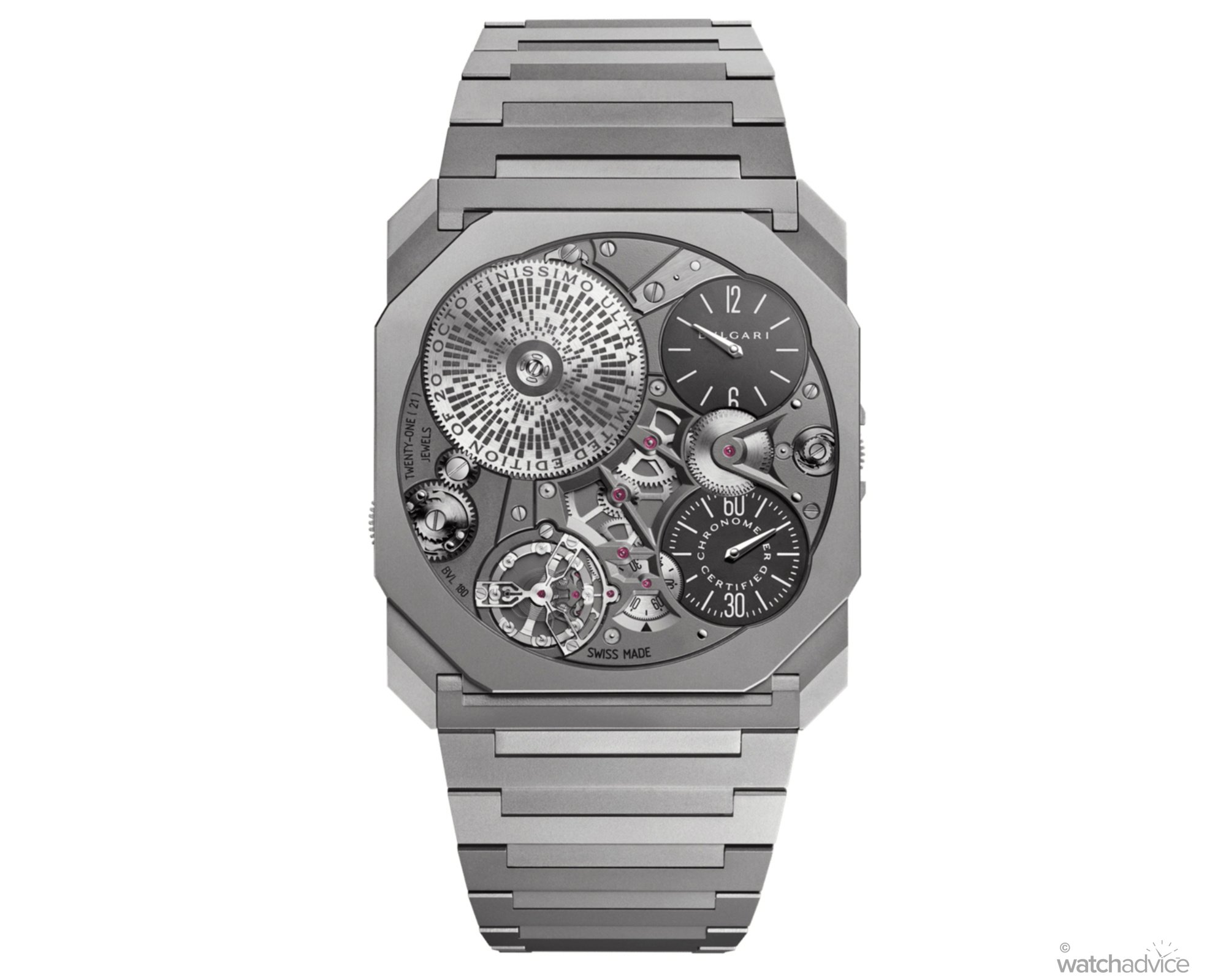
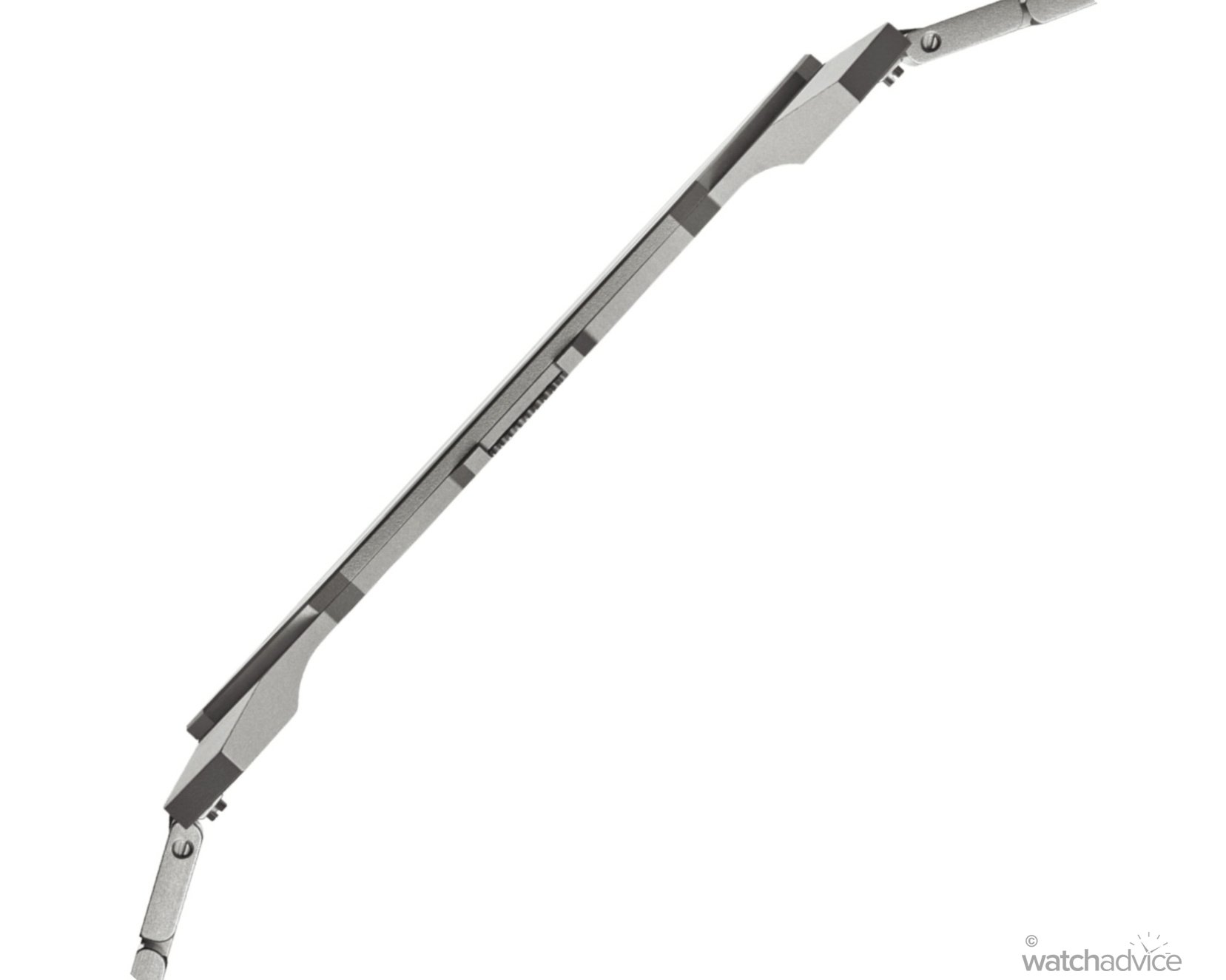
The Roman brand did make a few small aesthetic changes to the dial, however, which showcased the tungsten carbide main plate, an openwork dial, hour and minute regulator display counters in sandblasted titanium with PVD treatment and black PVD hands. It also has on display a second wheel with a black index indicator, winding and time-setting wheels in sandblasted stainless steel, a sandblasted stainless steel ratchet wheel, which incidentally doubles as the barrel cover. On top of the ratched wheel/ barrel cover is a geometric design engraved with OCTO FINISSIMO ULTRA LIMITED EDITION OF 20.
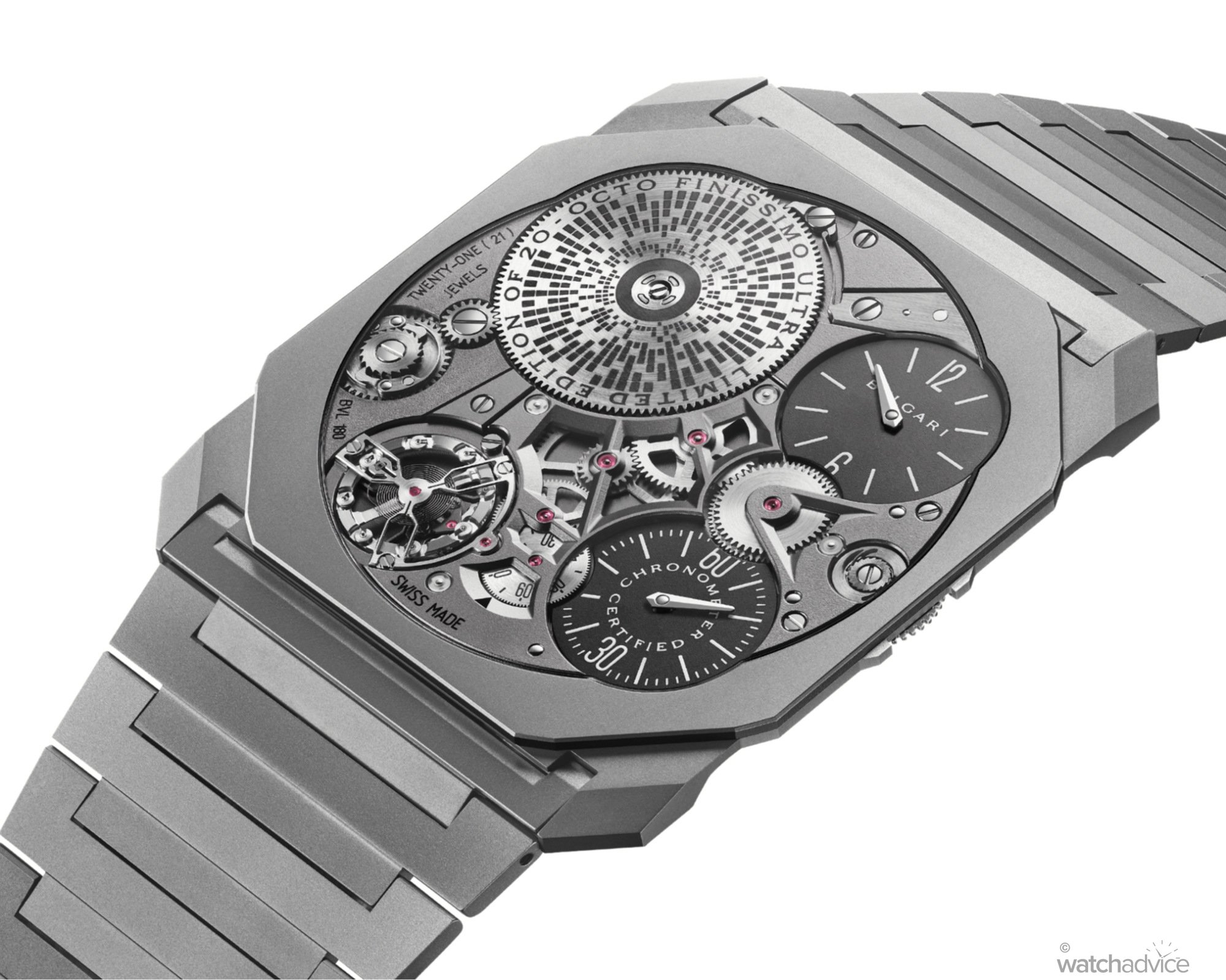
What is great about the 2024 Octo Finissimo Ultra COSC is, in my mind, twofold. The first being that it is COSC, so the thin movement isn’t just for show. The second being is Bvlgari essentially taking the 2022 version and making it better, saying to the watch world, “Oh, we can make it thinner, watch this!” The 2022 Octo Finissimo Ultrawas priced at €400,000 and limited to 10 pieces. The 2024 Octo Finissimo Ultra COSC is priced at US$529,000 in titanium and US$546,000 USD in platinum, both limited.
2025 – Bvlgari Octo Finissimo Ultra Tourbillon
This brings us to number 10, and this year’s record-breaking release. Unveiled at Watches & Wonders 2025, the Bvlgari Octo Finissimo Ultra Tourbillon took the crown as the world’s thinnest tourbillon watch, stealing it from Piaget’s Altiplano Ultimate Concept Tourbillon released in 2024.
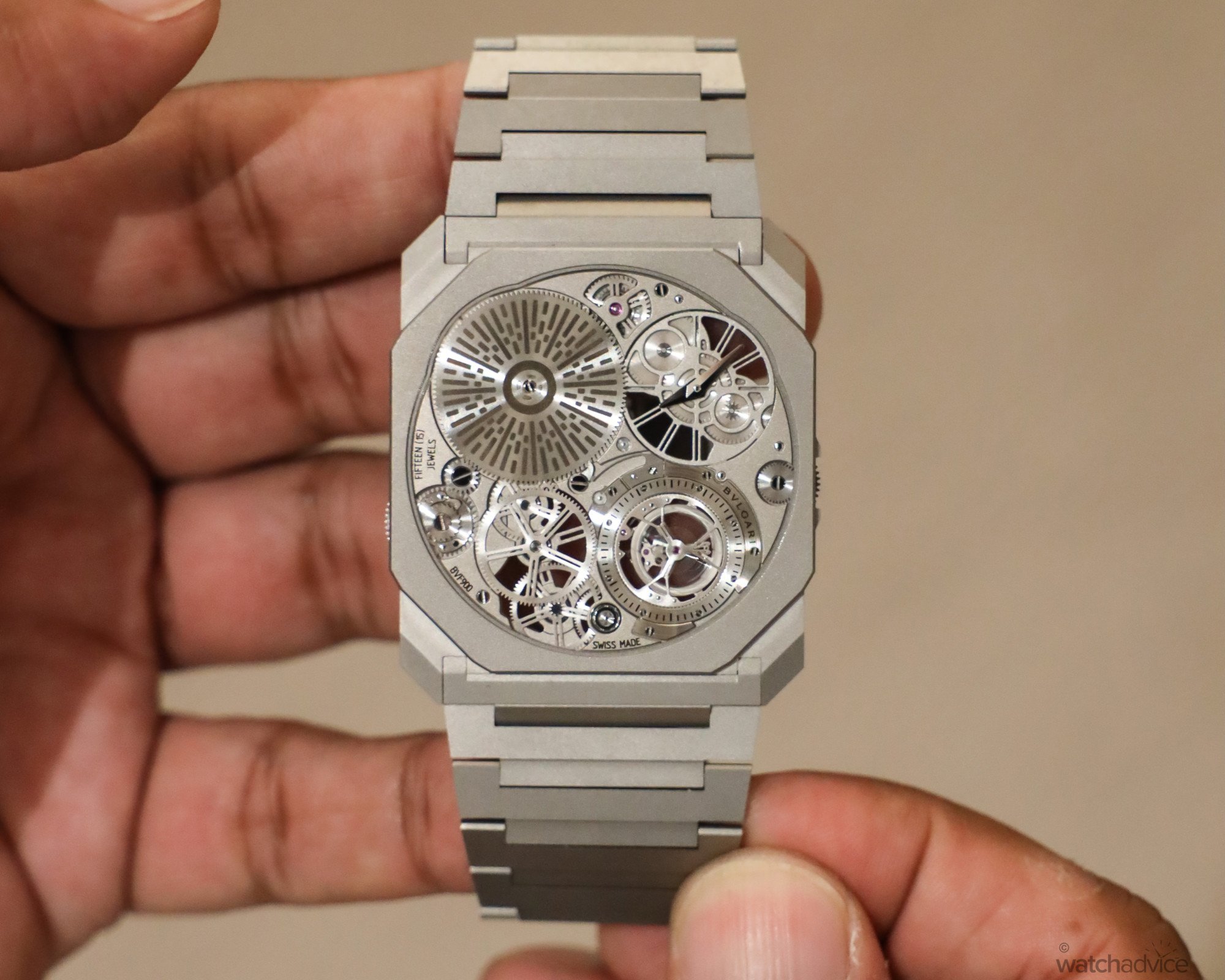
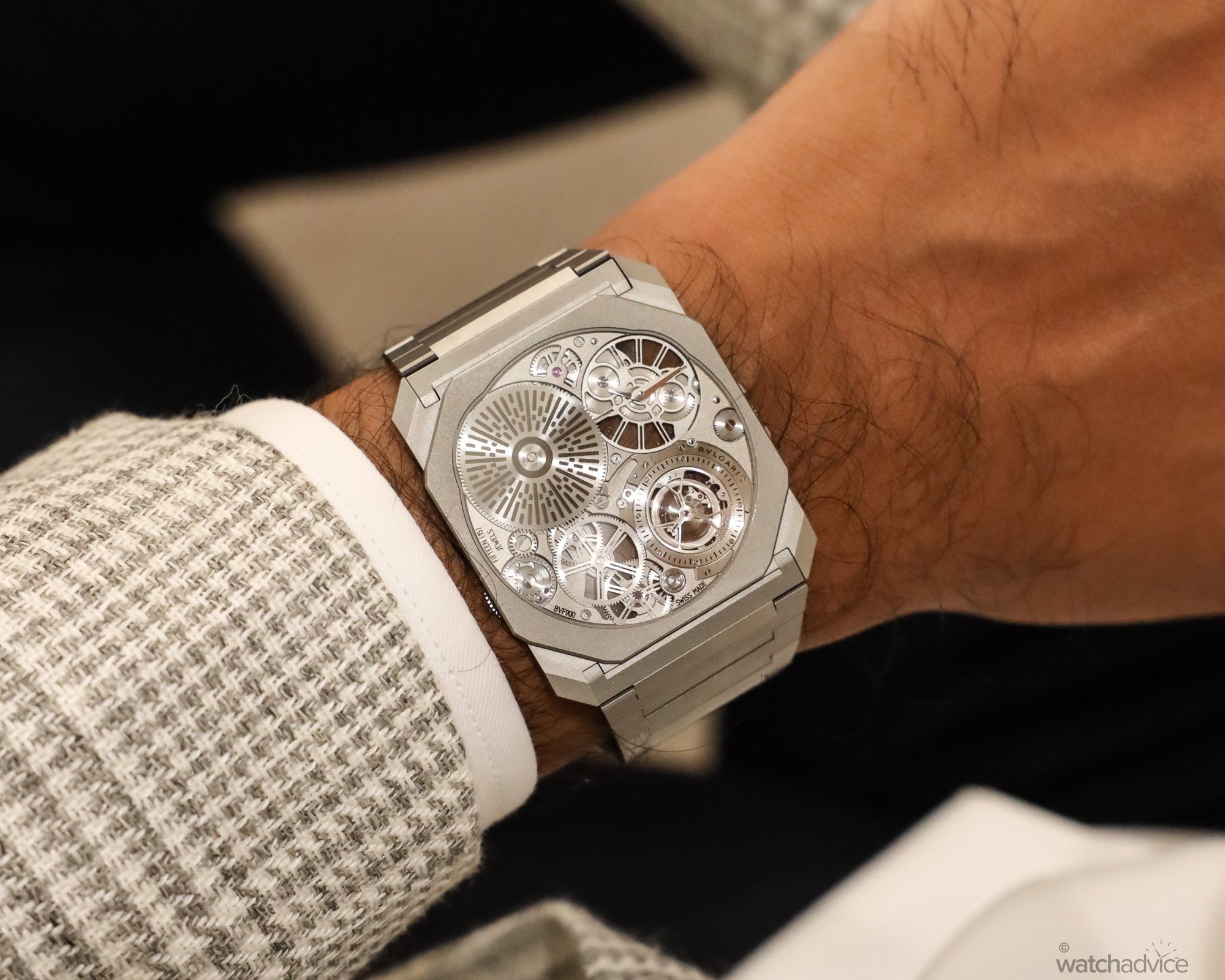
Not resting on it laurels, Bvlgari has designed a brand new calibre for this, the BVF900. It builds on all the knowledge from previous calibres that have gone before it, such as the ratchet wheel doubling as the barrel cover, the flying tourbillon and manual winding mechanism. Bvlgari has also built more of the movement into the case, which saves precious tenths of a millimetre in the overall design. The other element that the designers at Bvlgari have implemented in the new Ultra Tourbillon is the way the watch is wound and set. The movement is operated through two planar crowns – each subtly protruding from the case – positioned at 8 o’clock for winding and 3 o’clock for setting the time.
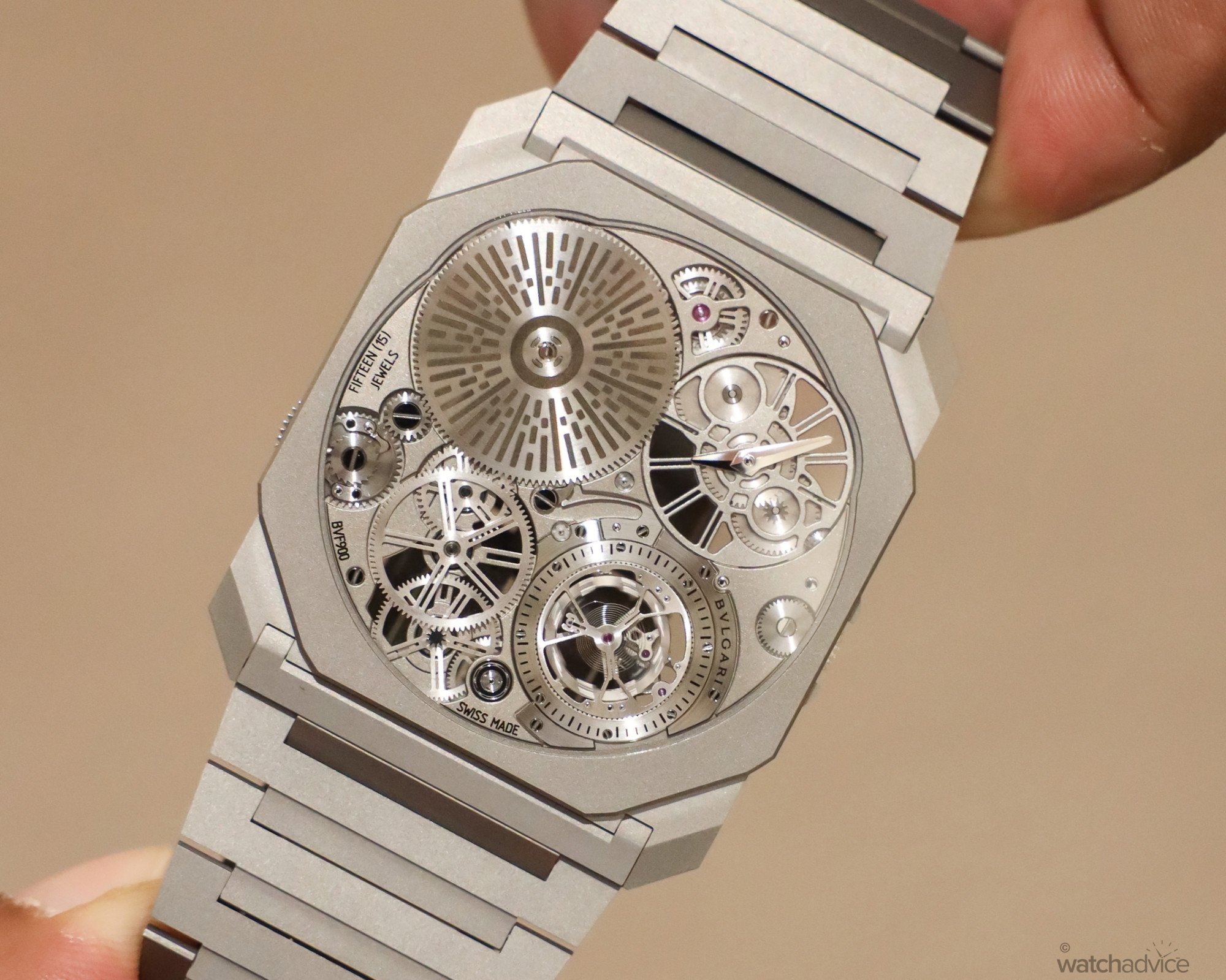
The BVF900 features a 42-hour power reserve, and while you may think this is a little on the low side these days, remember, this watch is just 1.85mm thin and does not have a standard mainspring. Adding to this, it beats at 4Hz, so the movement sacrifices a little power for more accuracy. I think I know what I’d take!
Having worn this watch and played with it in person, I can say that it is a very wearable piece, and it doesn’t feel like it will break – a somewhat irrational fear of mine with regard to ultra-thin watches. Having played around with the Konstantin Chaykin ThinKing at last year’s Geneva Watch Days, which does feel like you could bend it, the Bvlgari Octo Finissimo Ultra Tourbillon feels remarkably solid thanks to the sandblasted titanium case. If you’re thinking of owning one, then just be prepared to pay the US$678,000 Bvlgari is asking for each of the 20 pieces being produced!
So, with 10 records under the belt in just over 11 years, it will be interesting to see where Bvlgari will go next? Will they try to steal back the thinnest mechanical watch in the world title, currently held by the 1.65mm ThinKing? Will they decide to go one better on some of the more complicated pieces, like the perpetual calendar or minute repeater? With Geneva Watch Days around the corner, and 2026 not that far off, we will wait and see…


